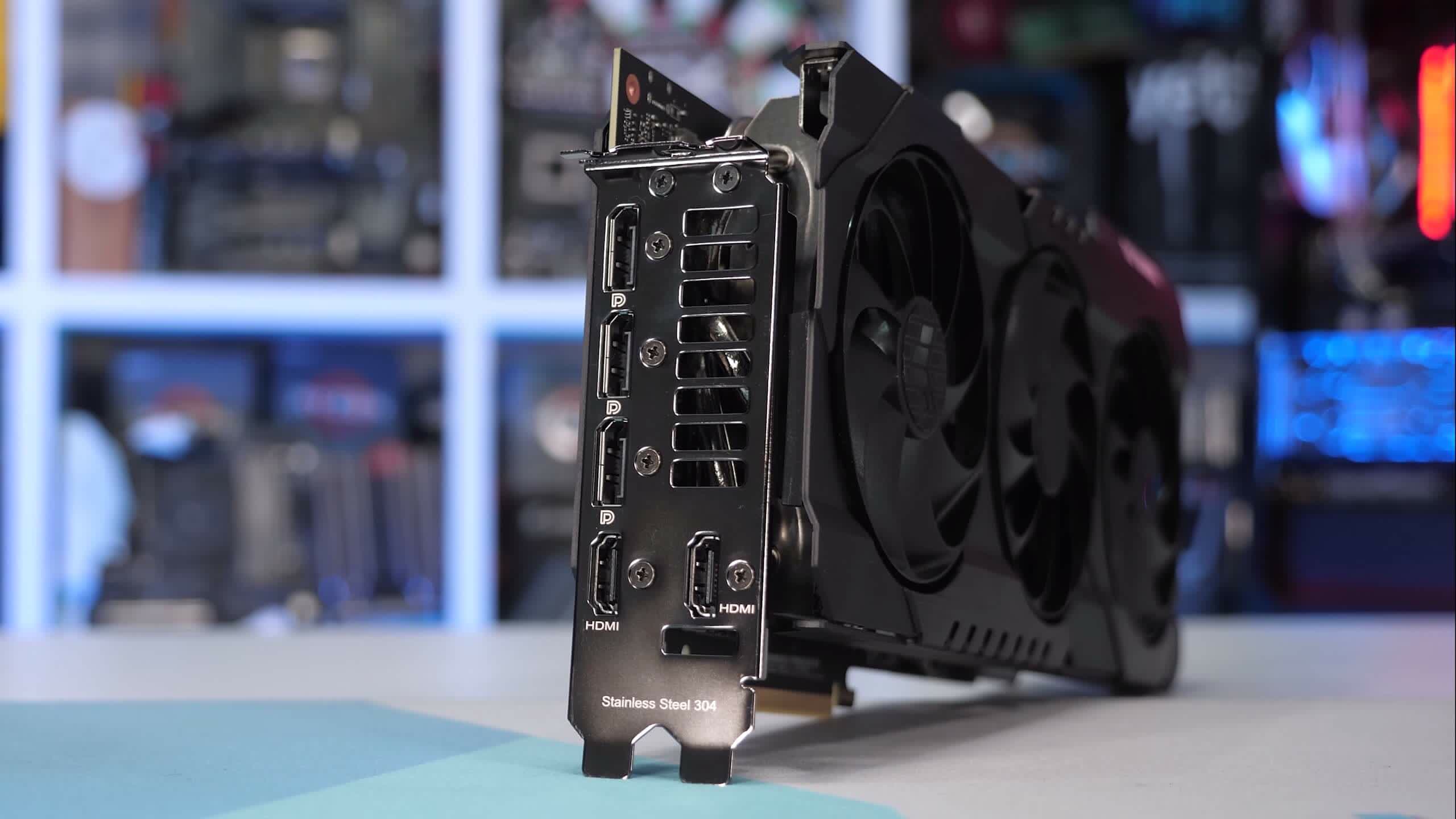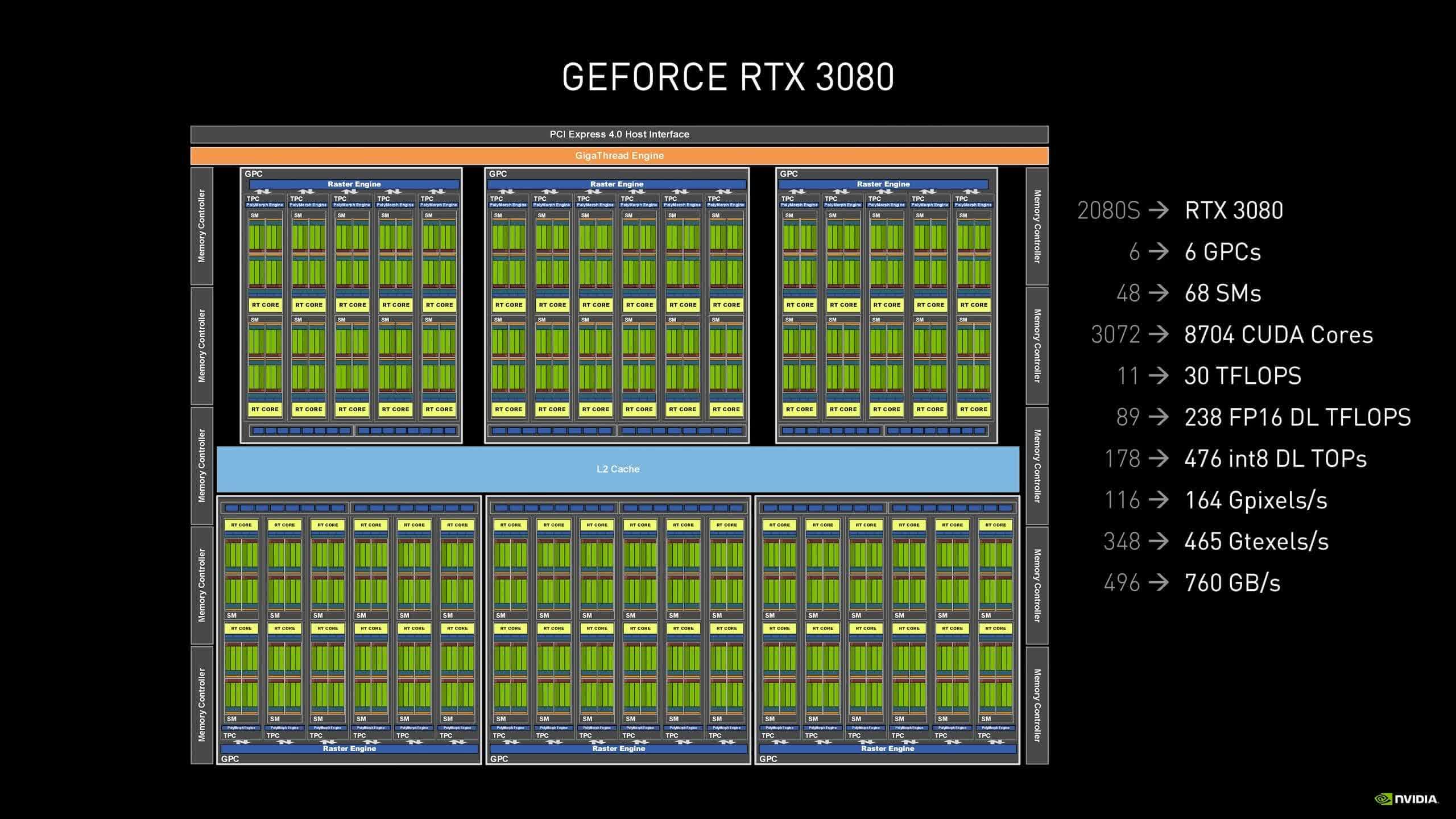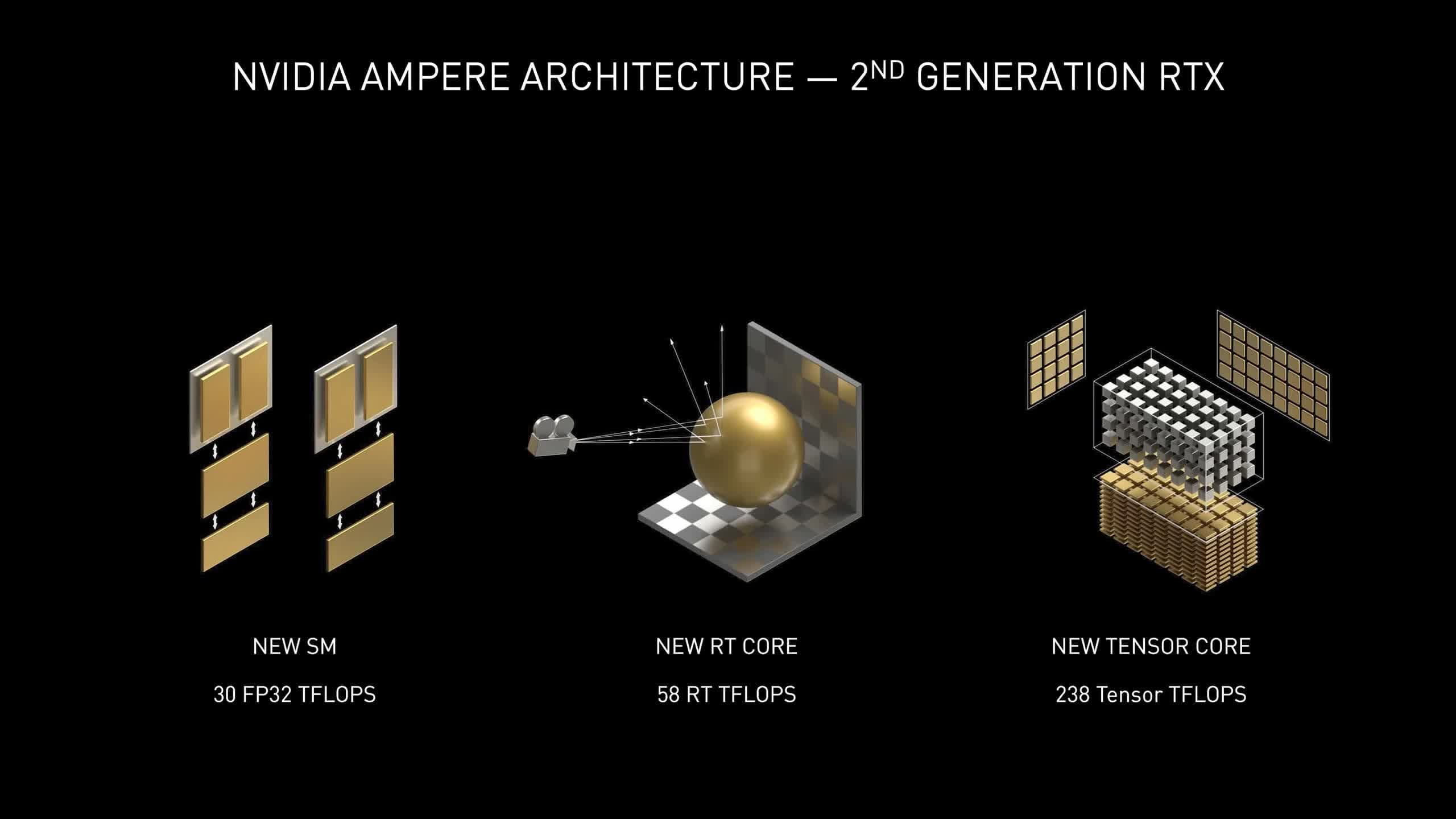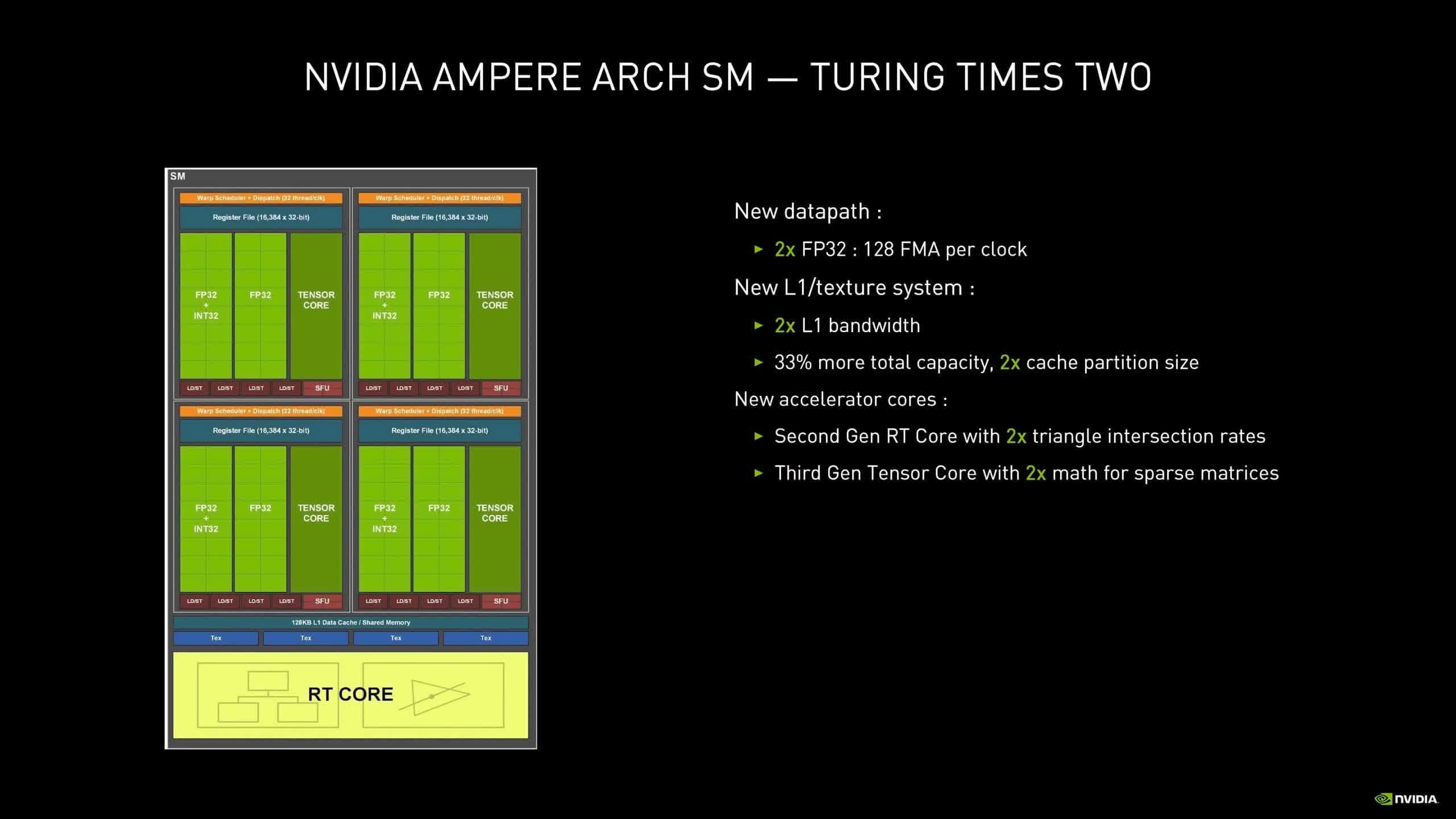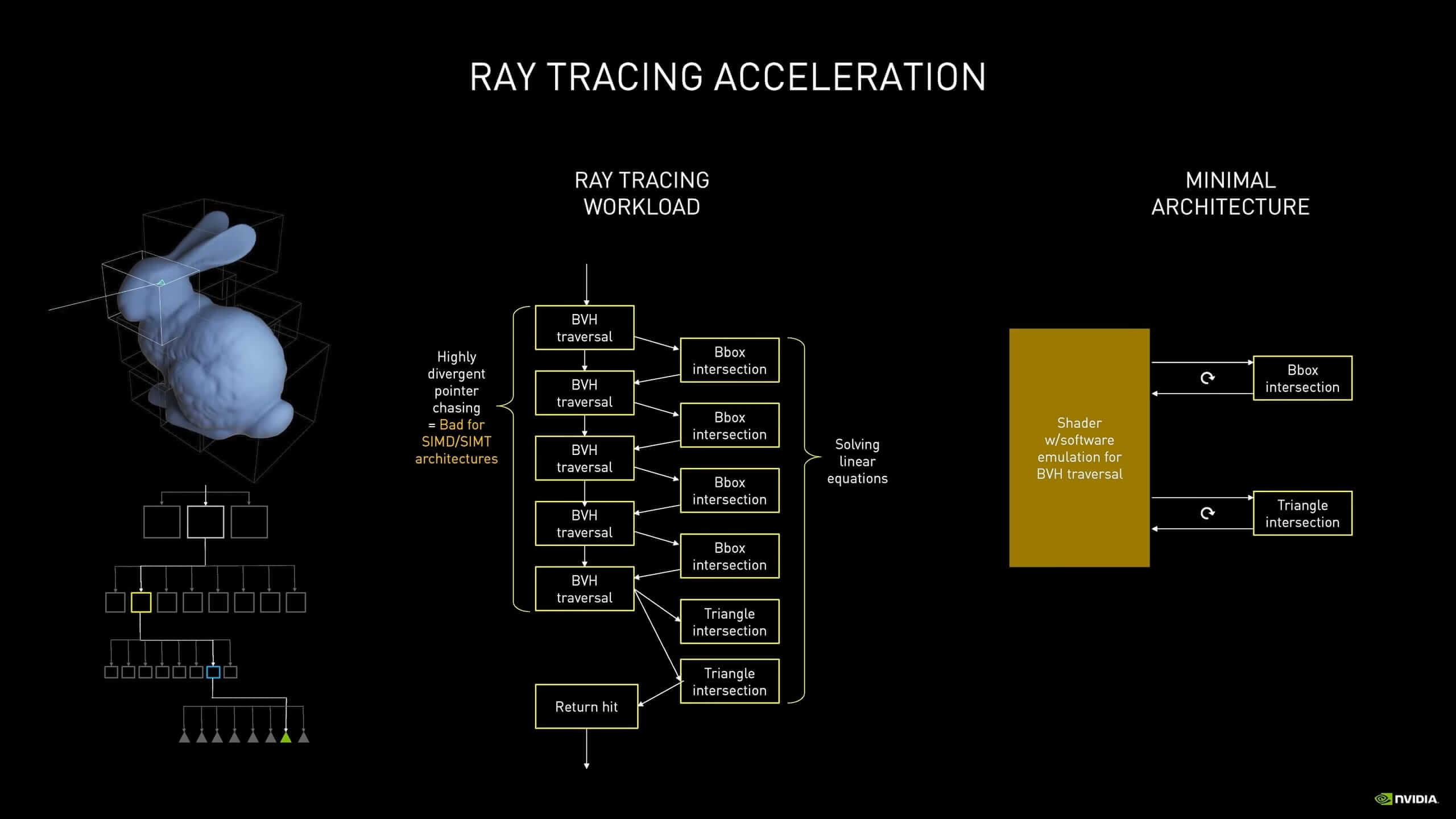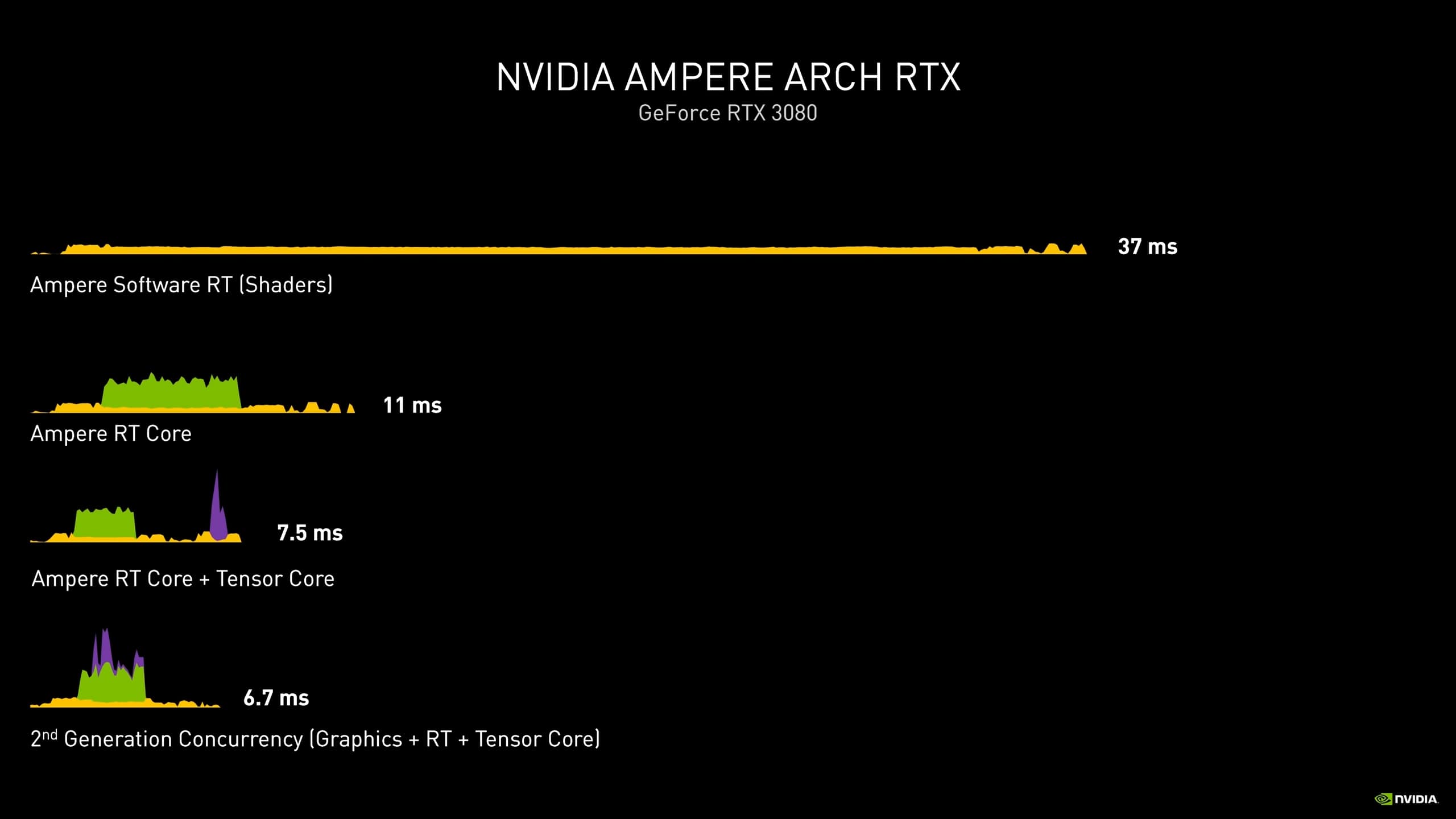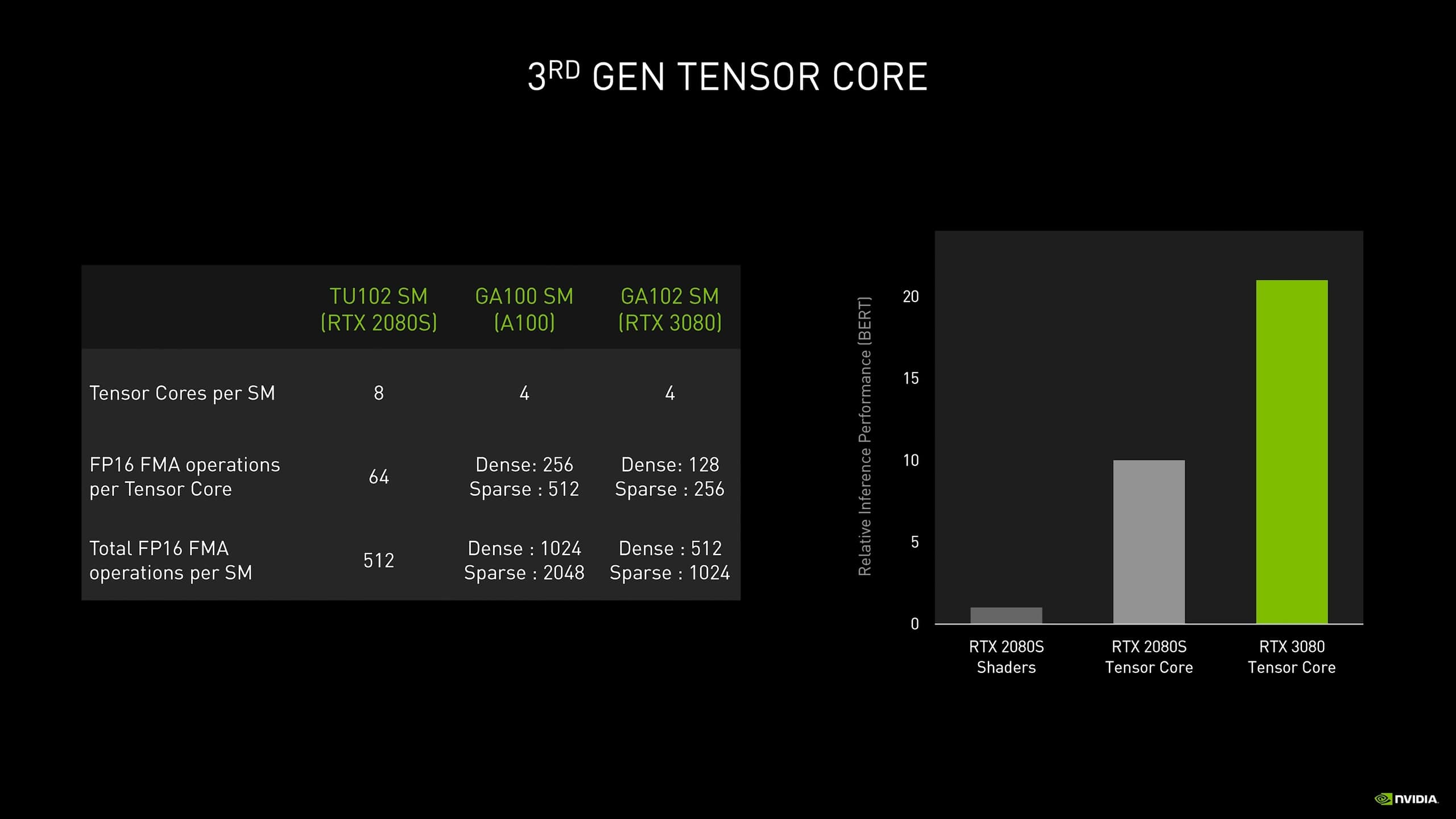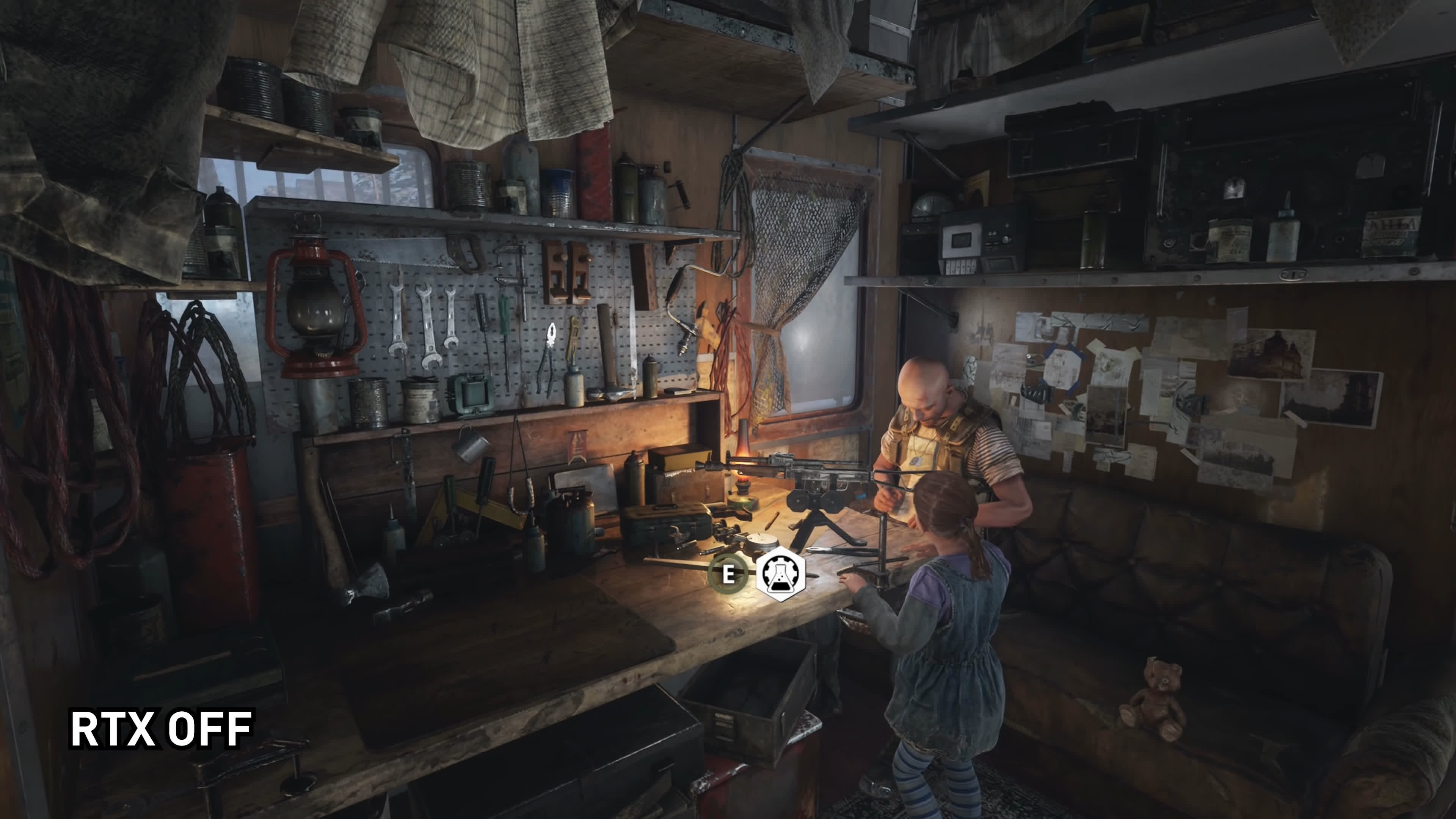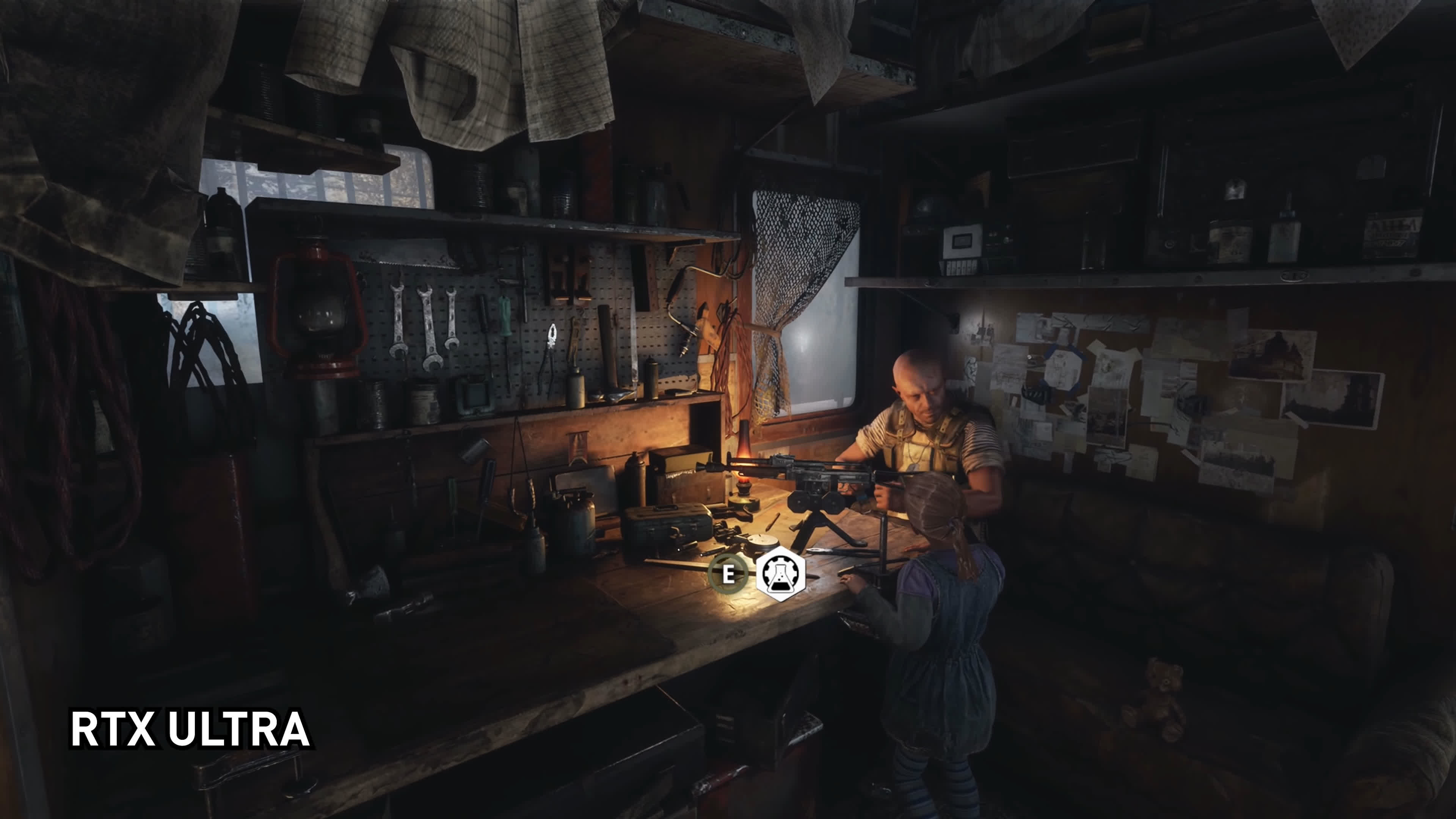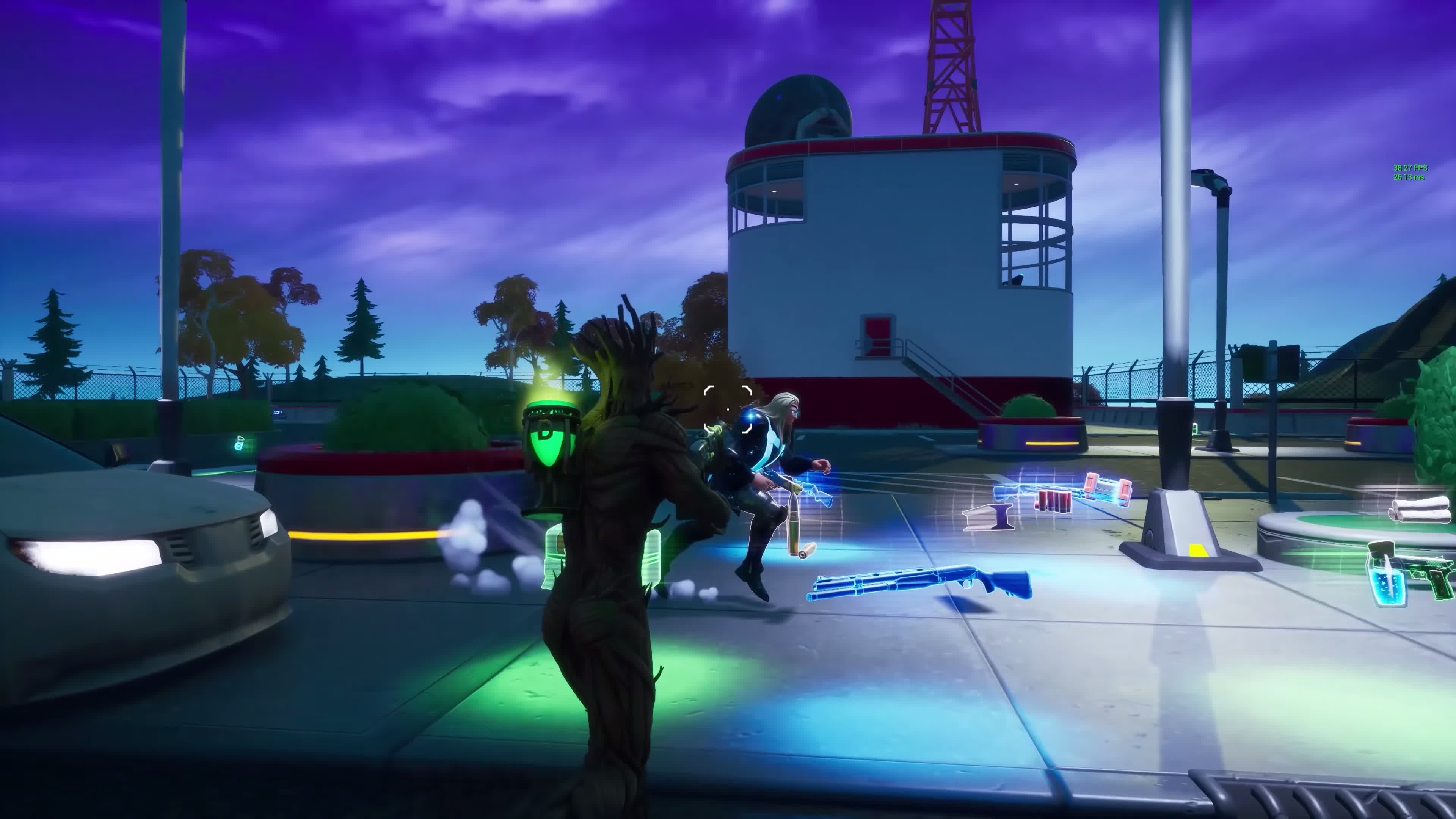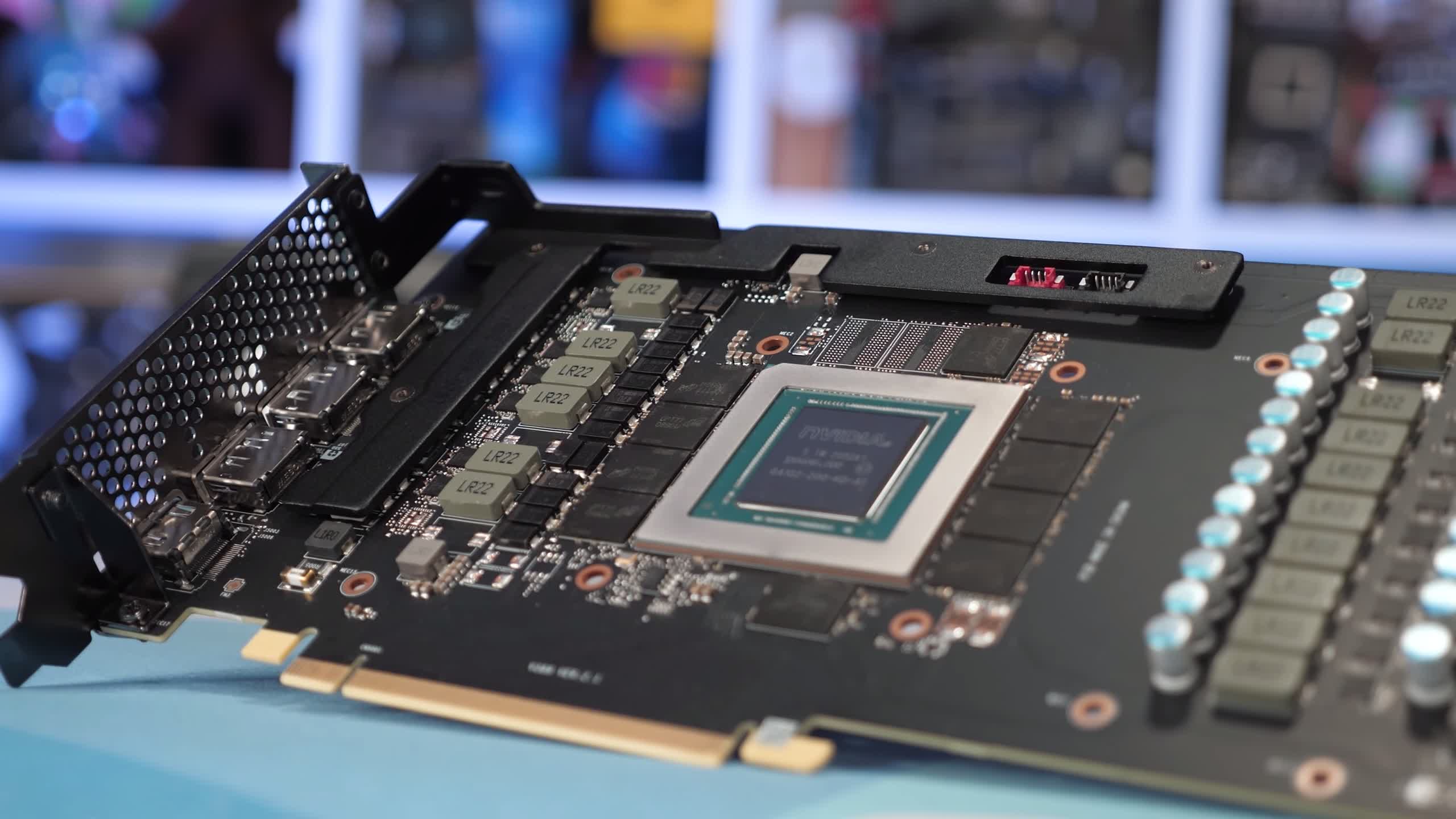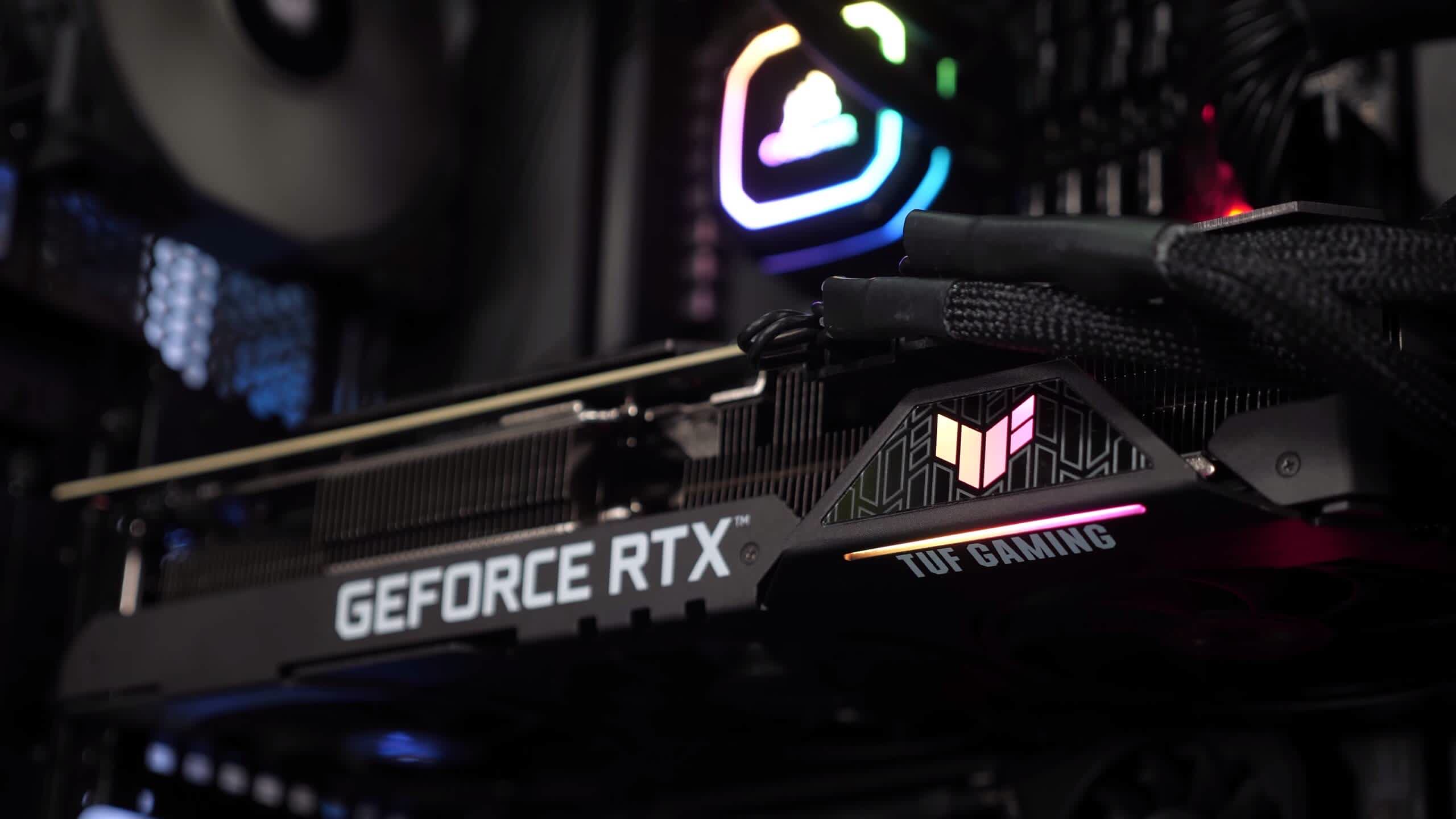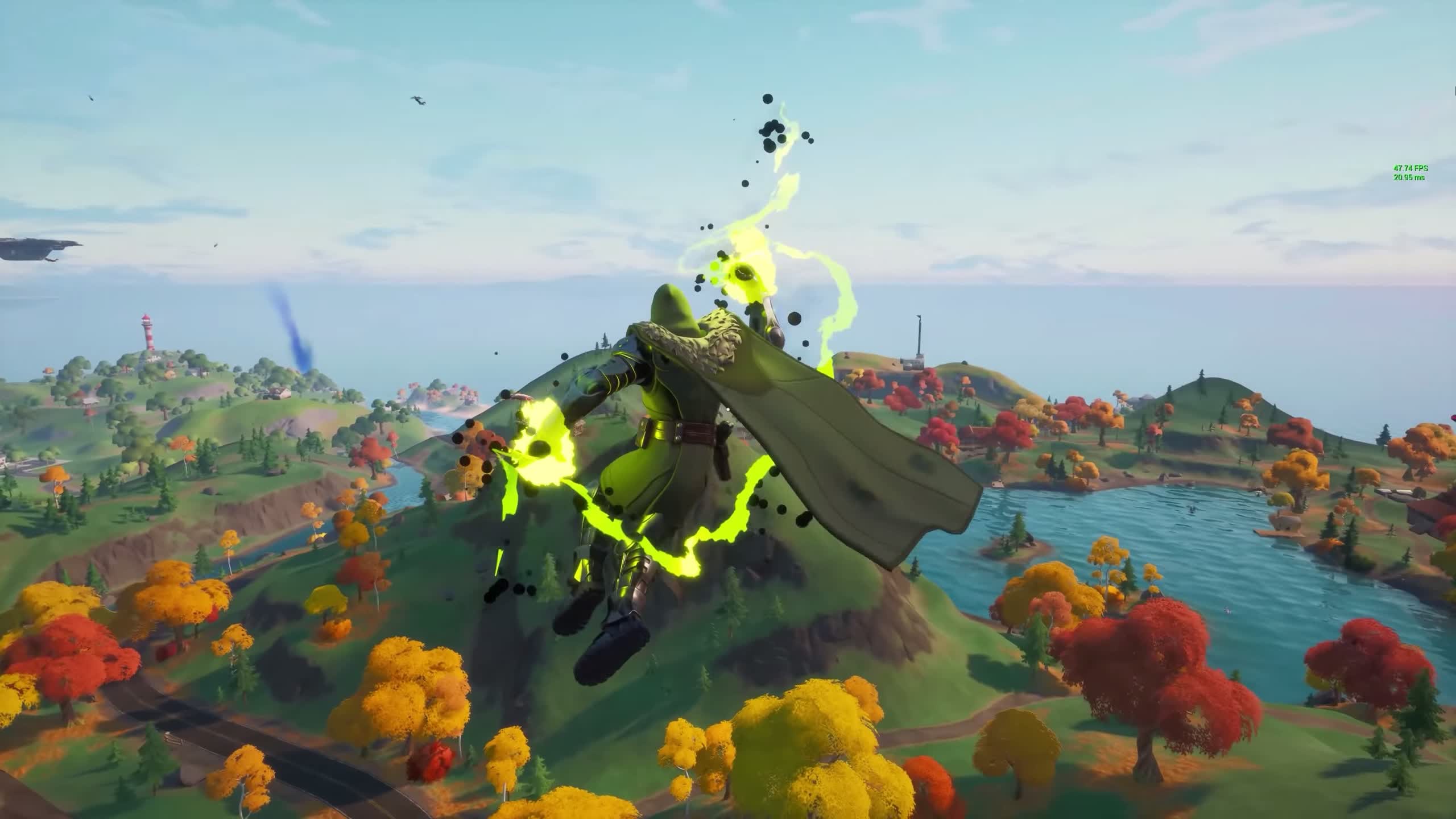With Nvidia's GeForce RTX 3080 out the door, it's time we take a deep dive into ray tracing and DLSS performance once again. We've already taken a comprehensive look into how the card performs in general and gave you a teaser of what to expect with RTX performance, but today we're going to show you just how fast the RTX 3080 is for these special effects in a wider range of games.
We'll be placing particular focus on comparing the RTX 3080 against the RTX 2080 Ti just because that was the fastest GPU you could get before for ray tracing, but for good measure you will also see results for the RTX 2080 and 2070. As you'd expect, we plan to discuss RTX on versus RTX off, which is the main talking point when it comes to ray tracing in particular.
First, let's go through some of Nvidia's claims about the RTX 3080's RTX capabilities and some of the changes they've made to the Ampere architecture versus Turing. The two big ones come in the form of updated, next-generation RT and Tensor cores...
On the RT side, Nvidia says that Ampere is using a second-generation RT core, which packs three main improvements. The first is double the ray-triangle intersection throughput, this isn't the only thing that an RT core can do and is only part of the ray tracing picture, but it's the part that's received a speed up.
Not everything is faster in this RT core versus Turing, but we do get a big improvement to ray-triangle intersection. Ampere also supports improved concurrent processing, and introduces support for hardware accelerated ray-traced motion blur.
Ampere also brings us up to a third-generation Tensor core design, with Turing being the second-gen and Volta the first-gen. While the Ampere SM features half the tensor cores per SM, each tensor core is faster, so the overall SM delivers the same performance at minimum, or 2x the performance in some workloads compared to Turing, depending on the data type. There's also support for new data types with Ampere.
While these are sort of the low-level changes Nvidia has made to Ampere, there are questions marks as to how these improvements will translate into real-world game performance. In Nvidia's launch presentation, they spent a lot of time comparing the RTX 3080 to the RTX 2080 or RTX 2080 Super in ray traced workloads, showing a 1.5 to 1.8x improvement between those two parts. But these gains aren't just coming from the 2nd-gen RT core and 3rd-gen Tensor core design, the RTX 3080 also simply features more RT cores, so we'll unpack today whether these ray tracing improvements are down to a brute force approach of adding more RT cores, or whether the RT cores themselves are faster.
All our benchmark data was captured using a GPU test rig comprising a Ryzen 9 3950X and 32GB of low latency DDR4-3200 memory in a dual rank configuration.
Benchmarks
We'll start with the oldest ray tracing game in our line-up, Metro Exodus. This is an interesting one because the game only supports DLSS, not DLSS 2.0, so the image quality you gain from the feature is lackluster to put it lightly. What we're interested in here is whether the RTX 3080 is a capable card for native resolution ray tracing, because we can't imagine you will want to play with DLSS enabled in this title.
There's good stuff and bad stuff to see in Metro. The good is that the RTX 3080 is faster than the RTX 2080 Ti for ray tracing at 4K. We're seeing a 30% performance improvement, which makes the game somewhat playable at 4K using the Ultra preset with ray tracing.
Cards like the RTX 2080 and especially the 2070 look very slow in comparison, certainly those GPUs are nowhere near fast enough for 4K gaming in Metro with everything turned on.
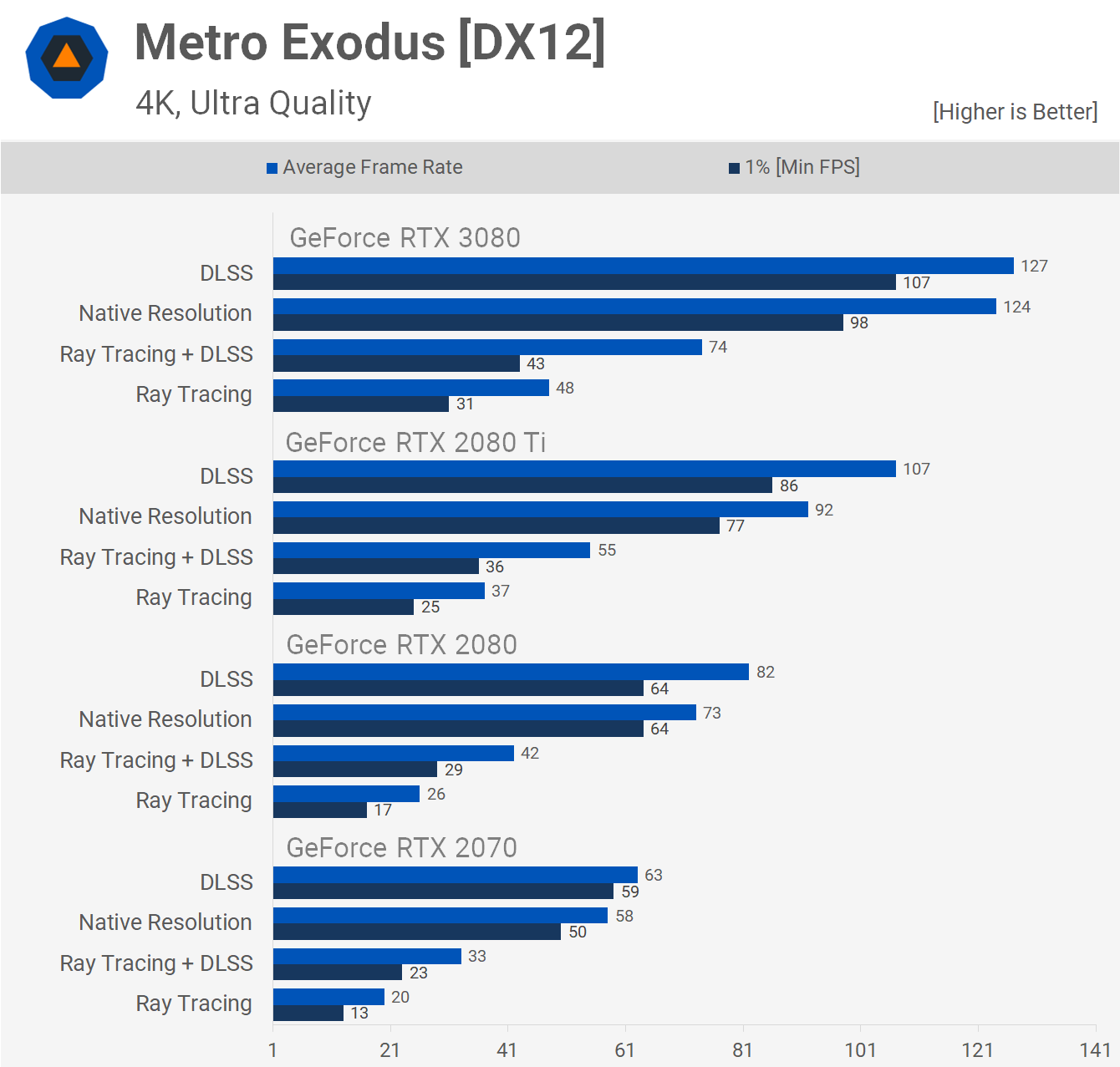
However, there's still an enormous performance difference between ray tracing enabled and disabled. With the RTX 3080, there is a 61 percent performance drop with RT enabled, which is equivalent to the performance drop seen when you turn on ray tracing with the RTX 2080 Ti. This suggests that while the 3080 is faster for ray tracing overall, that's down to simply being a faster card; the RT cores aren't any better at accelerating ray tracing in this game, as the performance delta between on and off is the same between Ampere and Turing.
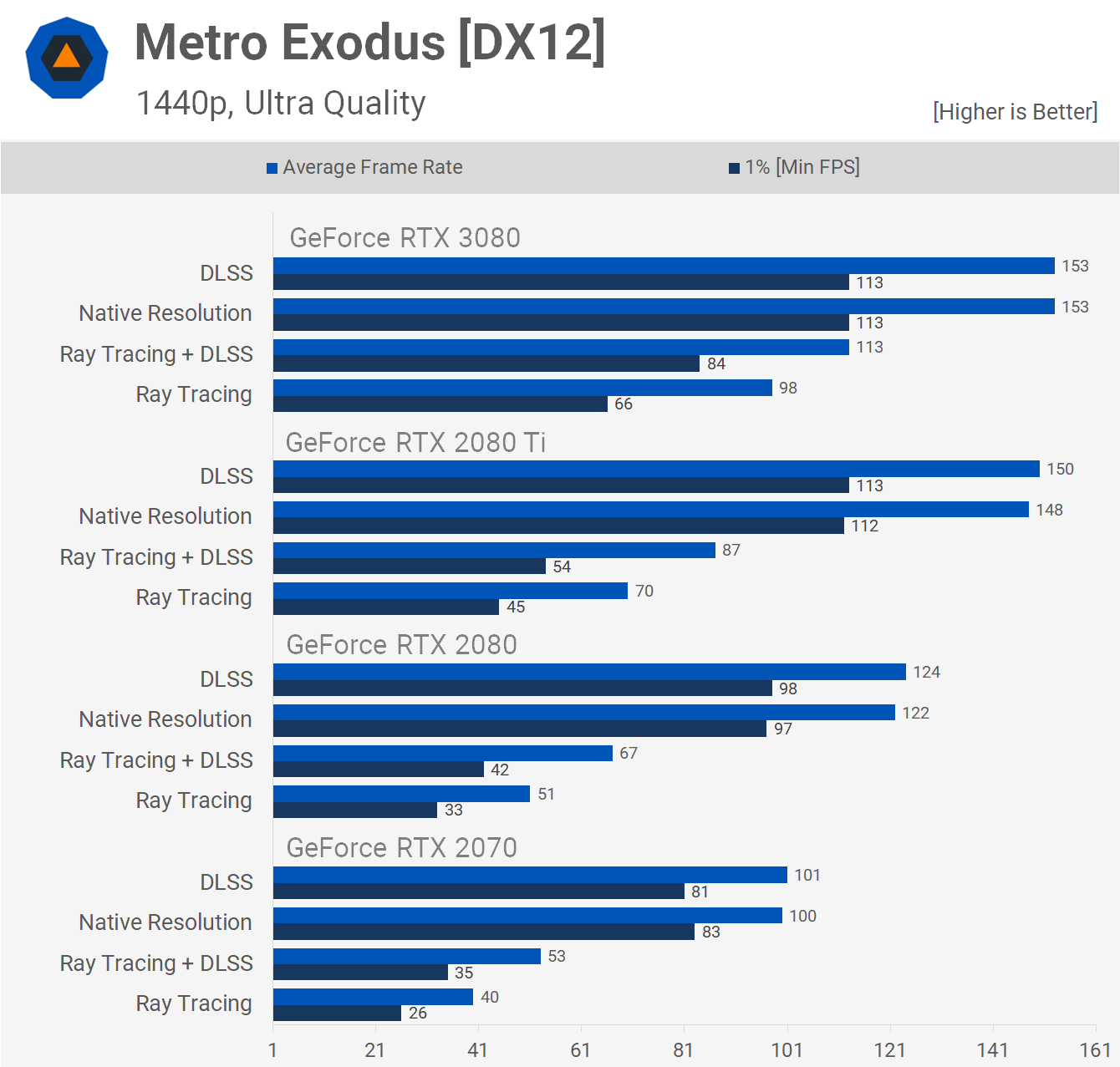
At 1440p we start to run into some of the limitations of the Ryzen 9 3950X test system, but the takeaway is largely the same.
There's still a large performance difference between RT on and off, however the RTX 3080 is simply faster overall. While the 2080 Ti was more of a 60 FPS card at 1440p with ray tracing, the 3080 starts to push up into higher refresh rates, which is a welcome improvement. It also demolishes the RTX 2080 at 1440p with a 92% performance boost with RT enabled.
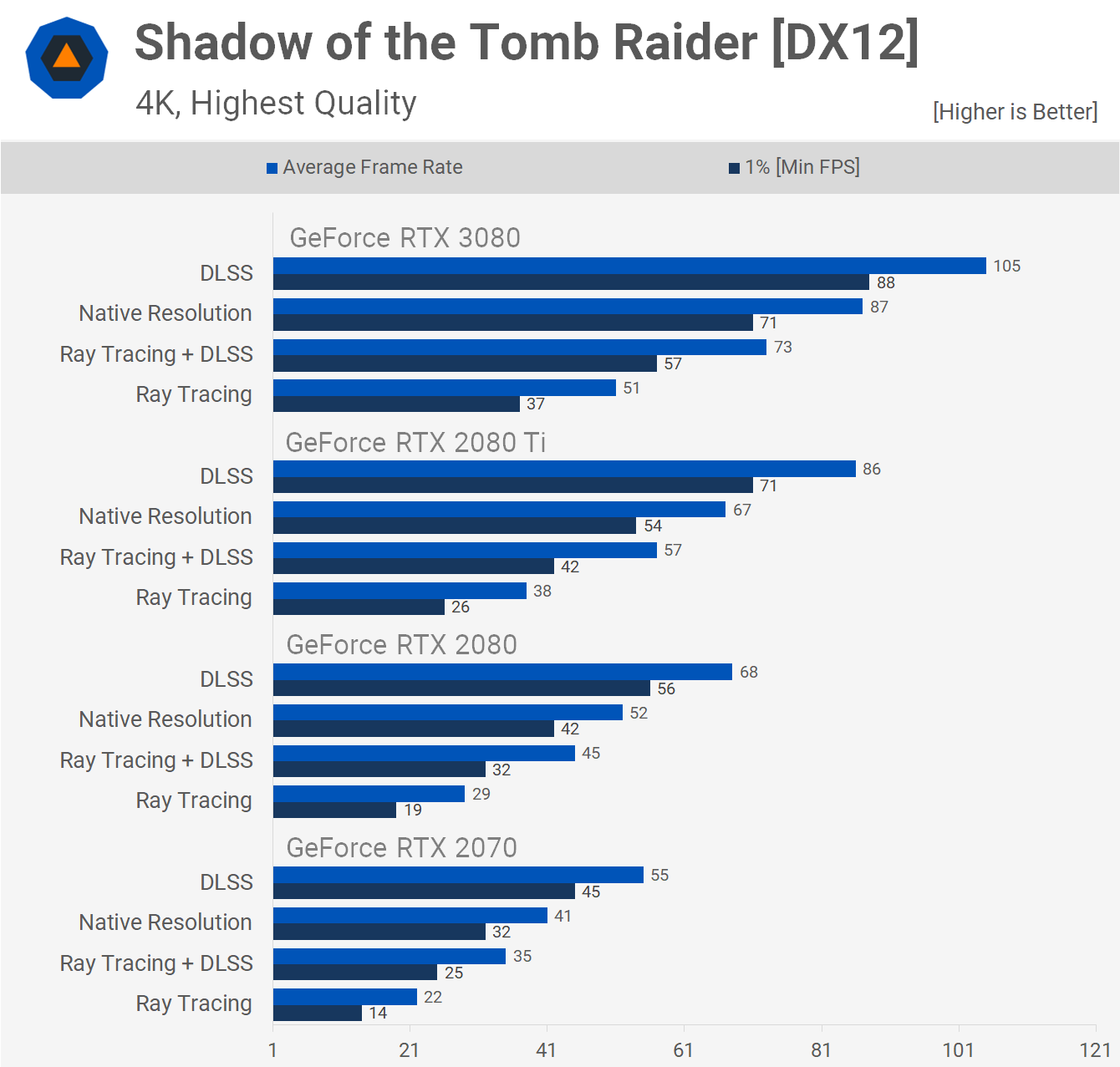
Shadow of the Tomb Raider includes ray traced shadows, but sticks to an older implementation of DLSS, so those results are only shown here for interest's sake, DLSS is bad here, too, so it's not worth using.
At native 4K using the highest quality settings, the RTX 3080 gets closer to being a 4K 60 FPS card with ray tracing enabled. A 34% performance improvement on the 2080 Ti is decent, slightly higher than the 30 percent gain we get in this title without RT enabled. There's no doubt the 3080 is much faster than the 2080, we're seeing 76% higher performance and this is key because the 2080 was not powerful enough for ray tracing at 4K.
There's still a big gap between RT on and off. The RTX 3080 sees a 41% drop to frame rate with RT enabled, compared to 43% with the RTX 2080 Ti, so the 3080 is about 5% faster at accelerating ray tracing in SoTR. That's not a significant improvement though, so you'll still have to choose between high frame rates, or ray tracing in this game.
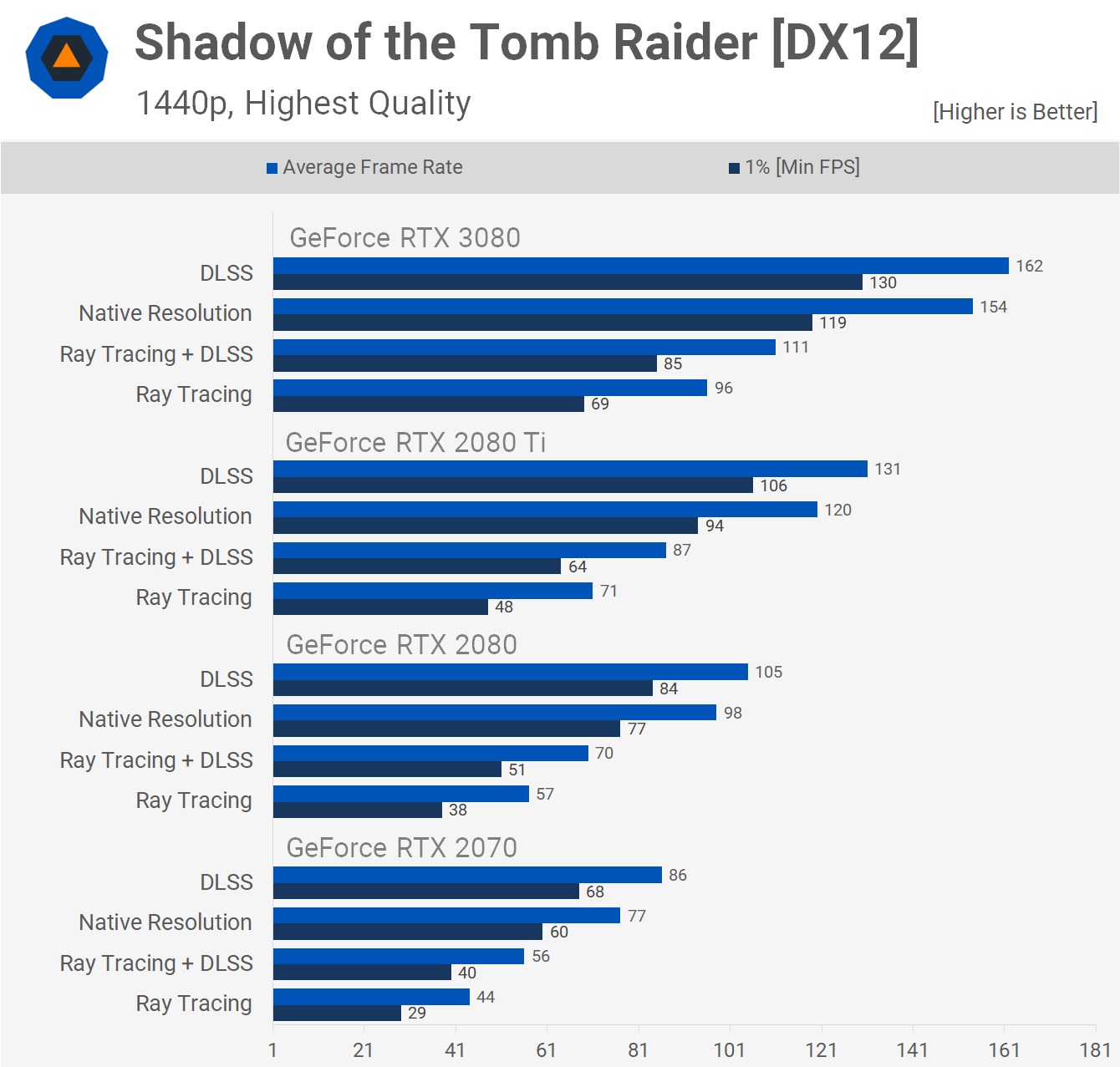
At 1440p, the RTX 3080 is 35% faster than the 2080 Ti with ray tracing enabled, compared to 28% faster with RT disabled. Both cards see a ~40% drop to performance with ray tracing enabled. At this resolution, it's a choice between maxing out a 144Hz monitor with the 3080, or playing with decent but lower frame rates with ray tracing.
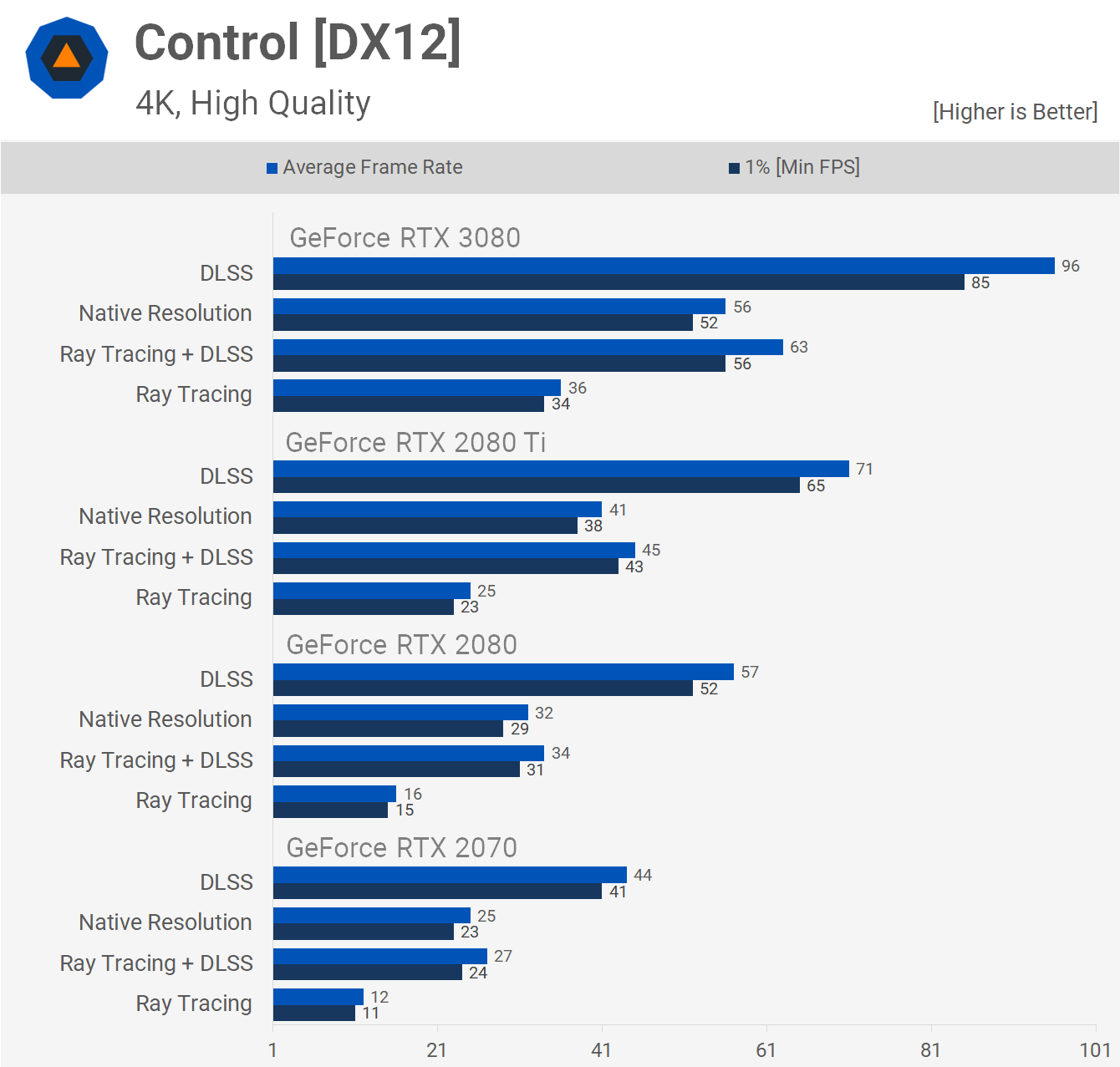
Control is where things start to get much more interesting, because now DLSS 2.0 becomes a factor.
Just looking at native 4K gaming with and without ray tracing to begin with, the RTX 3080 is 44% faster than the RTX 2080 Ti using the max quality settings, which includes both ray traced reflections and ambient occlusion. This is a larger margin than the previous two games, and with a 125% lead on the RTX 2080, the 3080 is a beast for 4K ray tracing even though the overall frame rate is a bit low. This is the first card that makes RT playable in this game at this resolution.
The 3080 sees a 36% drop to performance when ray tracing is enabled, versus 39% on the Turing-based 2080 Ti. This suggests the 3080 is about 8 percent better at accelerating ray tracing in this title.
But, you're far more likely to be playing Control with DLSS 2.0 enabled, as that provides near equivalent image quality to native 4K. Here all Nvidia cards tested are actually faster with ray tracing and DLSS enabled, compared to running at a native resolution without ray tracing, which is an ideal scenario where DLSS can be used to compensate for the added effects.
However, in our opinion that's far too simplistic of a comparison. As you can also use DLSS without ray tracing, the more accurate exploration is DLSS without ray tracing versus DLSS with ray tracing, because we don't really see why you'd run at a native resolution in this game. Most Nvidia GPU owners will be choosing between the high frame rates with DLSS, or the image quality offered with DLSS + ray tracing. When DLSS works this well, it's a given you want to turn that on first, then tweak the other settings to hit the performance you are after.
When looking at DLSS results, the RTX 3080 is 40% faster than the 2080 Ti with both ray tracing and DLSS enabled, and 85% faster than the 2080. The 3080 sees a 34% hit to frame rate when you enable ray tracing with DLSS already enabled, while the 2080 Ti sees a 37% hit. This is similar to the RT on vs off numbers at native resolution.
The RTX 3080 was 71% faster when enabling DLSS without ray tracing, and 75% with ray tracing. The RTX 2080 Ti was 73% faster without ray tracing, and 80% with ray tracing. This is using the highest quality DLSS option at this resolution.
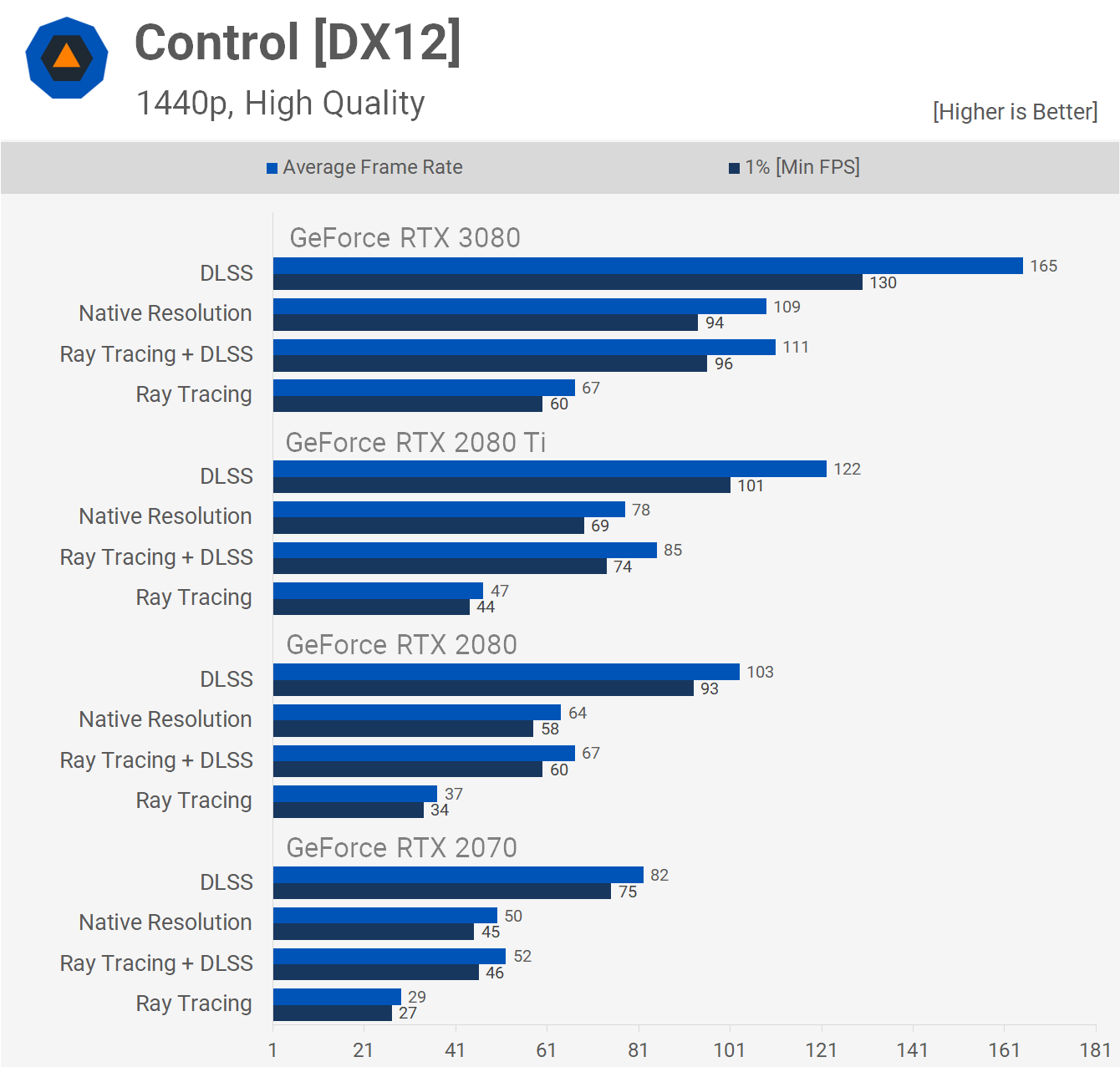
There's not too much else to say when running Control at 1440p. The performance hit due to enabling ray tracing is a little less severe at this resolution at around 30%, and overall performance is quite impressive with the RTX 3080.
The RTX 2080 was only a 1440p 60 FPS card with ray tracing and DLSS enabled, whereas the RTX 3080 is a true 1440p high refresh option.
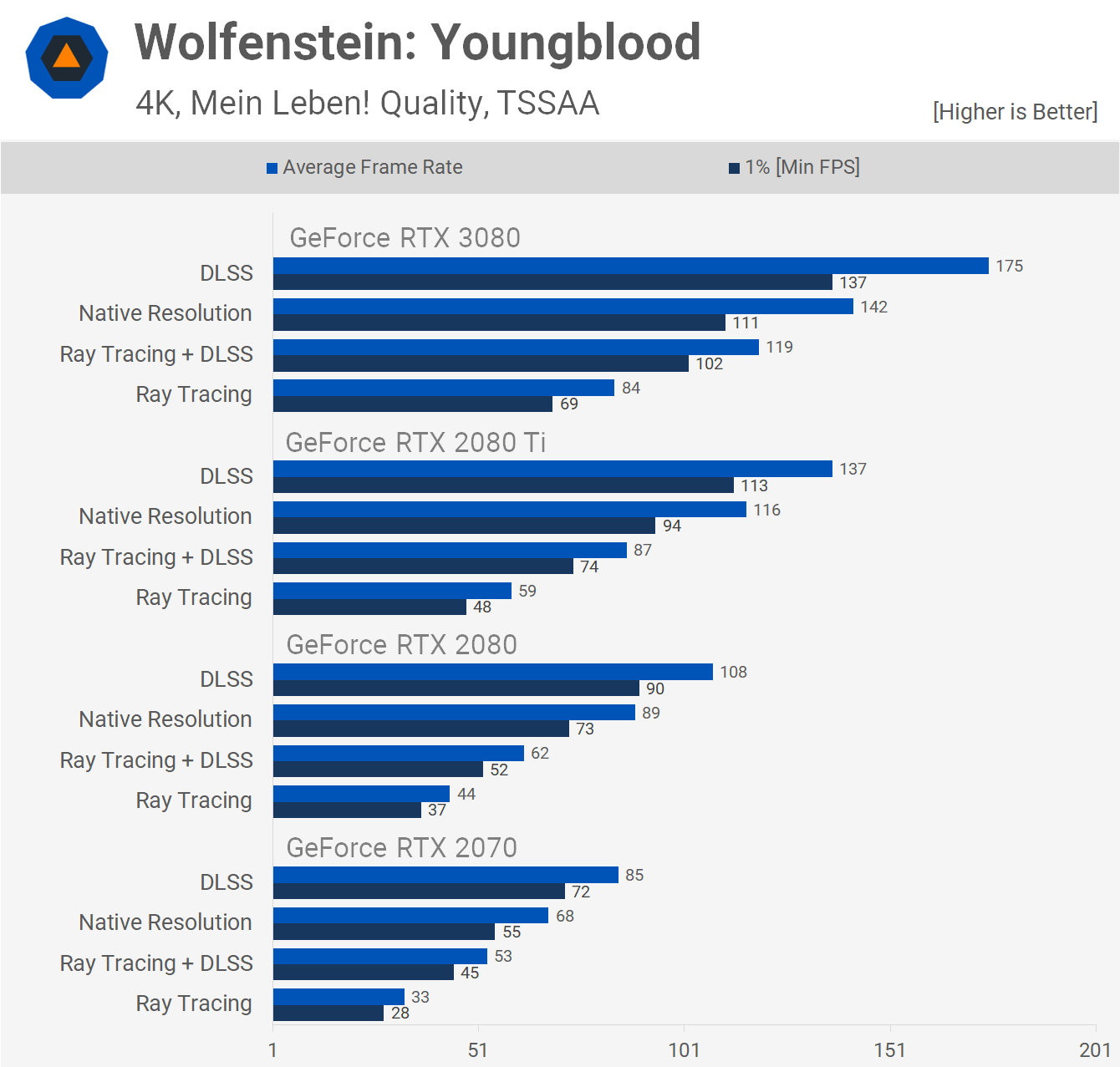
Next up is Wolfenstein: Youngblood and what we have here are two separate sets of data for the RTX 3080. The first set is with the game's current code, and the other, labelled "allow async present", is performance with an upcoming patch that is designed to better utilize Ampere's asynchronous compute capabilities (particularly for ray tracing).
Without the improvements to asynchronous compute, the RTX 3080 offers a 37% improvement to performance over the RTX 2080 when both DLSS 2.0 and ray traced reflections are enabled. But that increases to a much larger 54% when allow async present is enabled on the RTX 3080.
We also see over 2x the performance of the RTX 2080, taking respectable 4K 60 FPS performance right up into the realms of high refresh rate 4K.
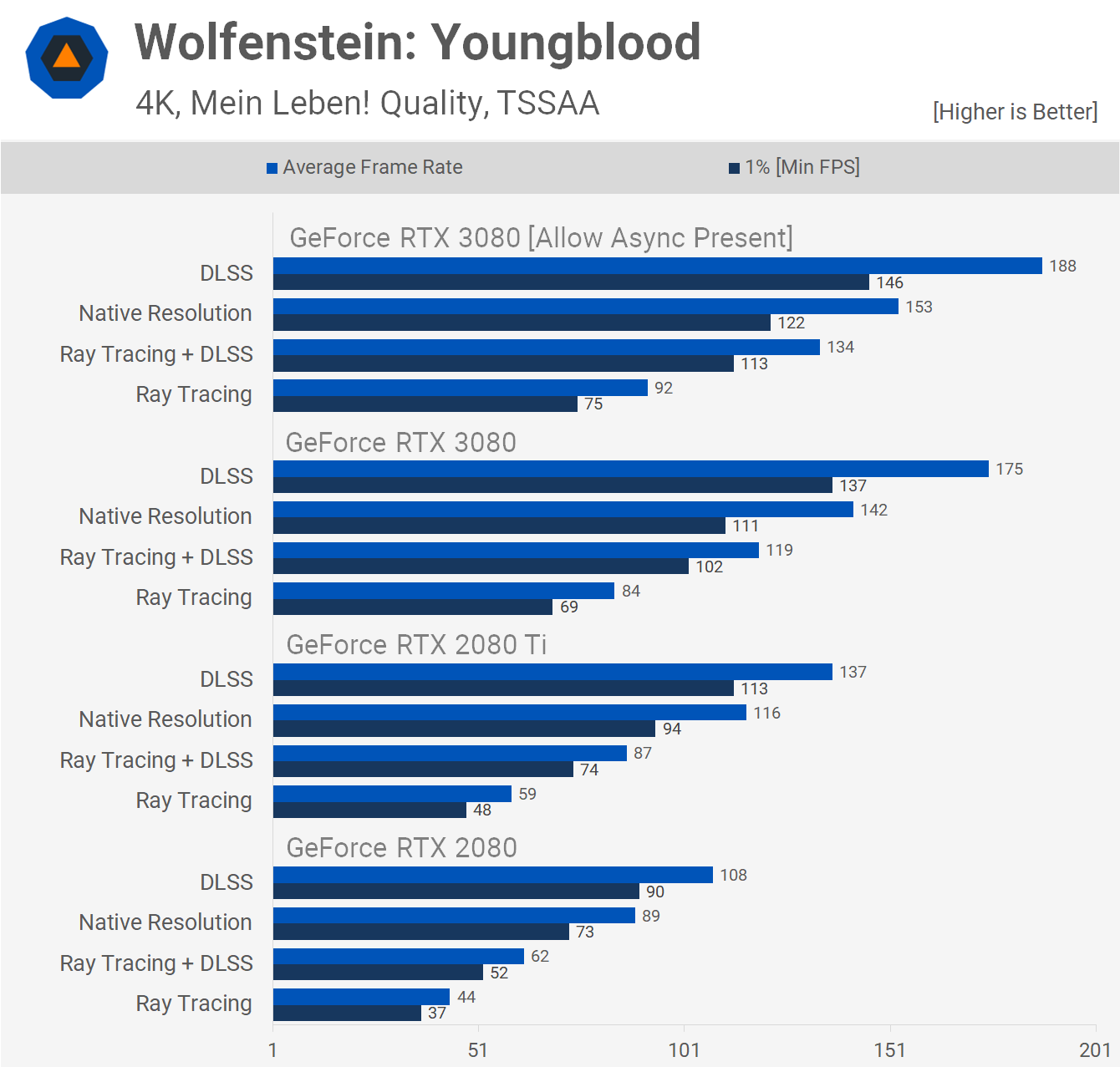
While increased asynchronous capabilities are nice, there's still that performance drop you can expect between running the game just with DLSS, and with DLSS plus ray tracing.
The RTX 2080 Ti saw a 36% drop to frame rate, the RTX 3080 without the new game patch saw a 32% drop, and with the new patch we saw a 29% drop. However, that makes the RTX 3080 24% better at accelerating both ray tracing and DLSS than the RTX 2080 Ti, which is a healthy gain.
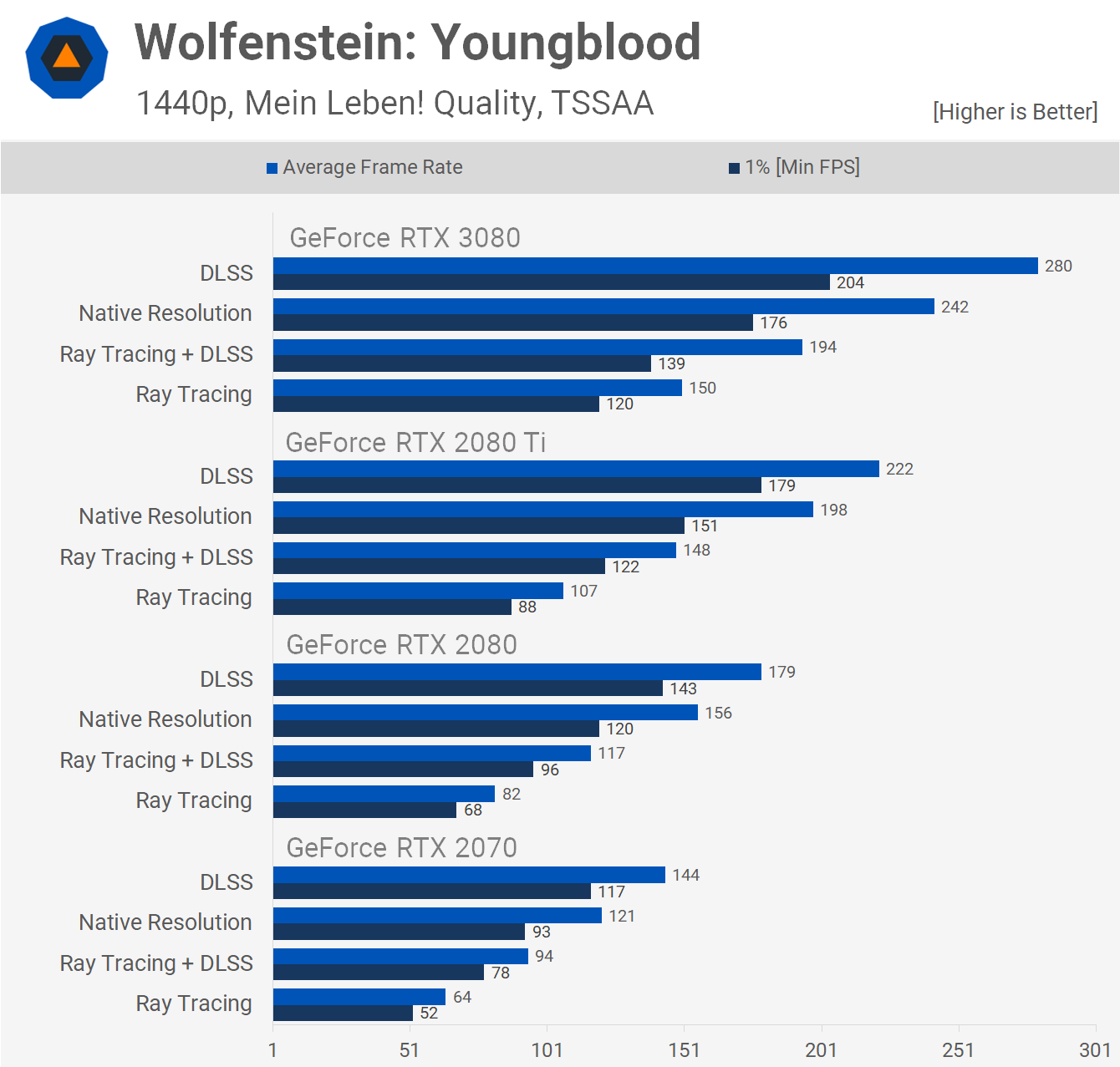
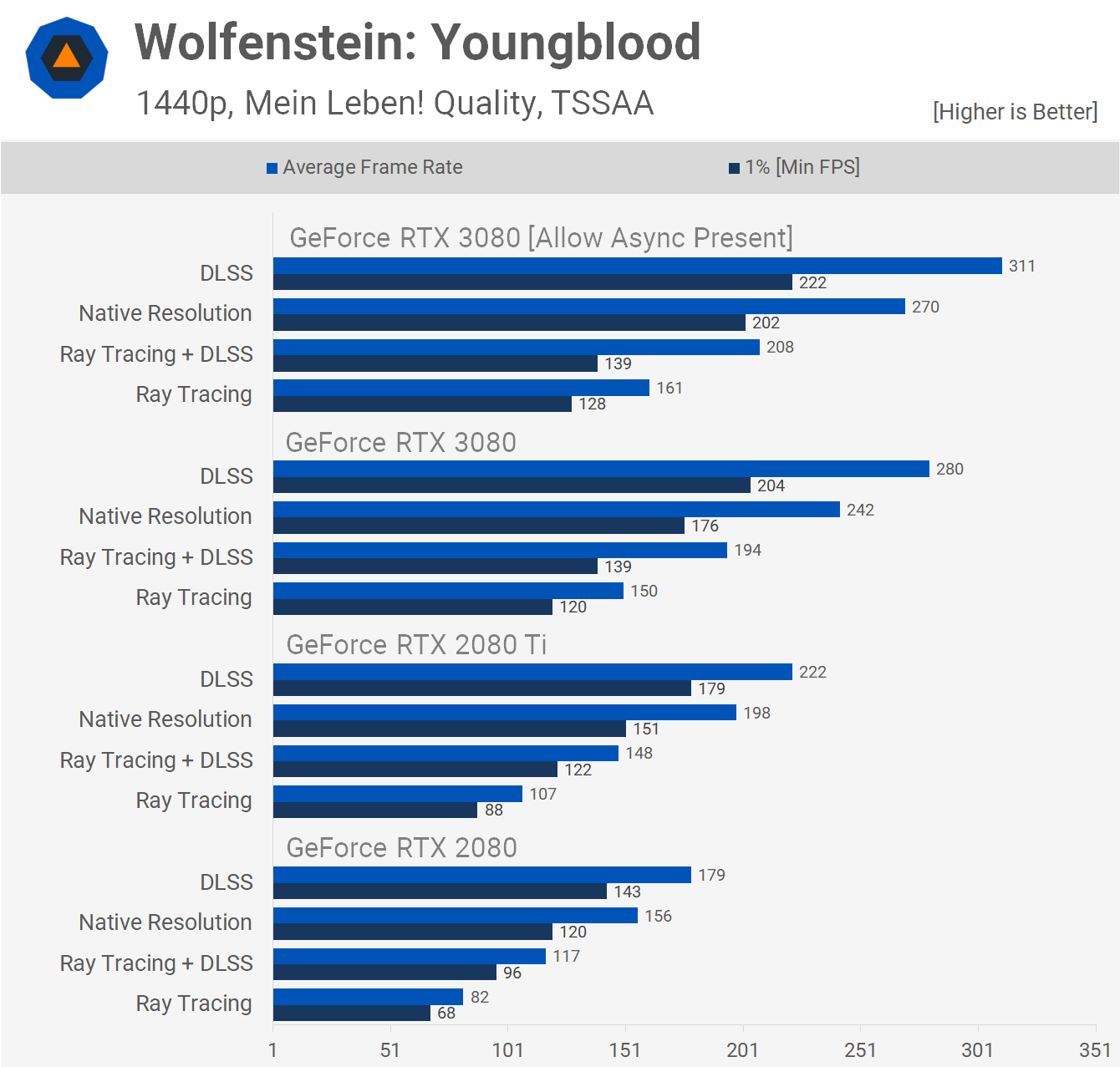
The gains aren't as significant at 1440p in this title, with the 2080 Ti and 3080 providing similar acceleration capabilities.
Overall, the RTX 3080 is a significant 41% faster than the 2080 Ti with ray tracing, DLSS 2.0, and "allow async present" enabled, but we're not getting the 54% gain we saw at 4K.
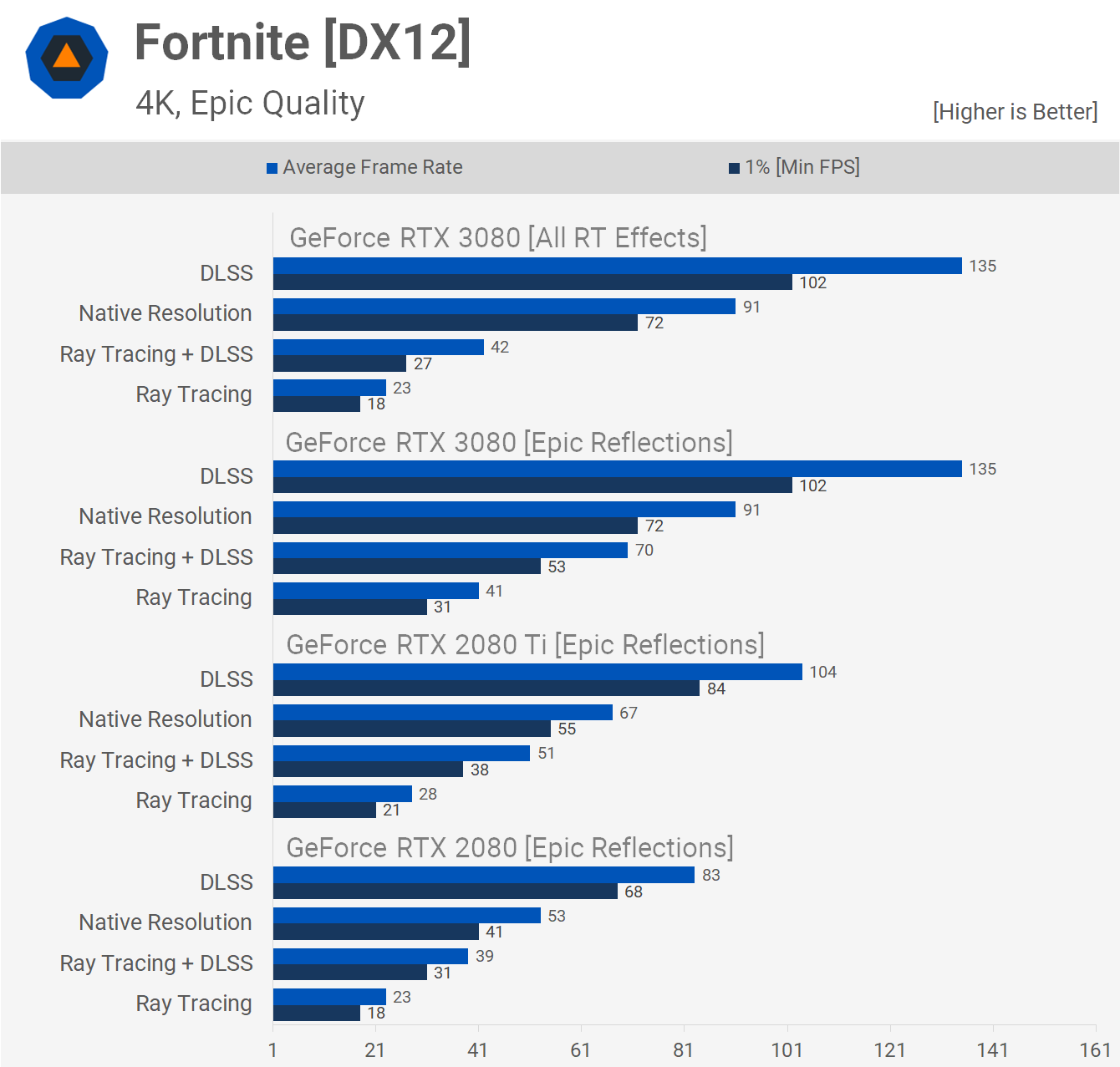
Fortnite is one of the latest titles to include ray tracing support, and it actually features quite a number of settings including shadows, reflections, ambient occlusion and global illumination. This comes at a hefty price, especially at 4K. Even with DLSS enabled, if you turn on all RTX effects with an RTX 3080 GPU, you're facing a reduction from 135 FPS, down to just 42 FPS. The game is unplayable with ray tracing and no DLSS at this resolution.
If you decide to only use reflections on the maximum setting - with reflections being the most noticeable effect in the game - the performance hit is less savage, dropping down to just 70 FPS.
Still, with the 3080, turning on reflections to maximum will halve your frame rate, while you'll see just a third of the frame rate with all effects enabled. The same is seen with the RTX 2080 Ti, at least with only reflections enabled. A drop from 104 FPS with DLSS enabled, to 51 FPS with epic RT reflections, is a huge hit. However, the RTX 3080 is 37 percent faster than the 2080 Ti at ray tracing reflections in this title, so that's a solid result for this new generation. The RTX 3080 is also 80 percent ahead of the 2080.

At 1440p, the difference between RT on and off is even more severe than it was at 4K. The RTX 3080 is good for 212 FPS with DLSS enabled and no ray tracing, but drops below 100 FPS with epic reflections, and 76 FPS with all ray tracing effects.
For a fast paced game, that's an enormous performance hit. While the RTX 3080 is faster than other RTX GPUs in this title, in our opinion the performance level with ray tracing doesn't warrant turning it on over playing at super high frame rates by simply taking advantage of DLSS 2.0.
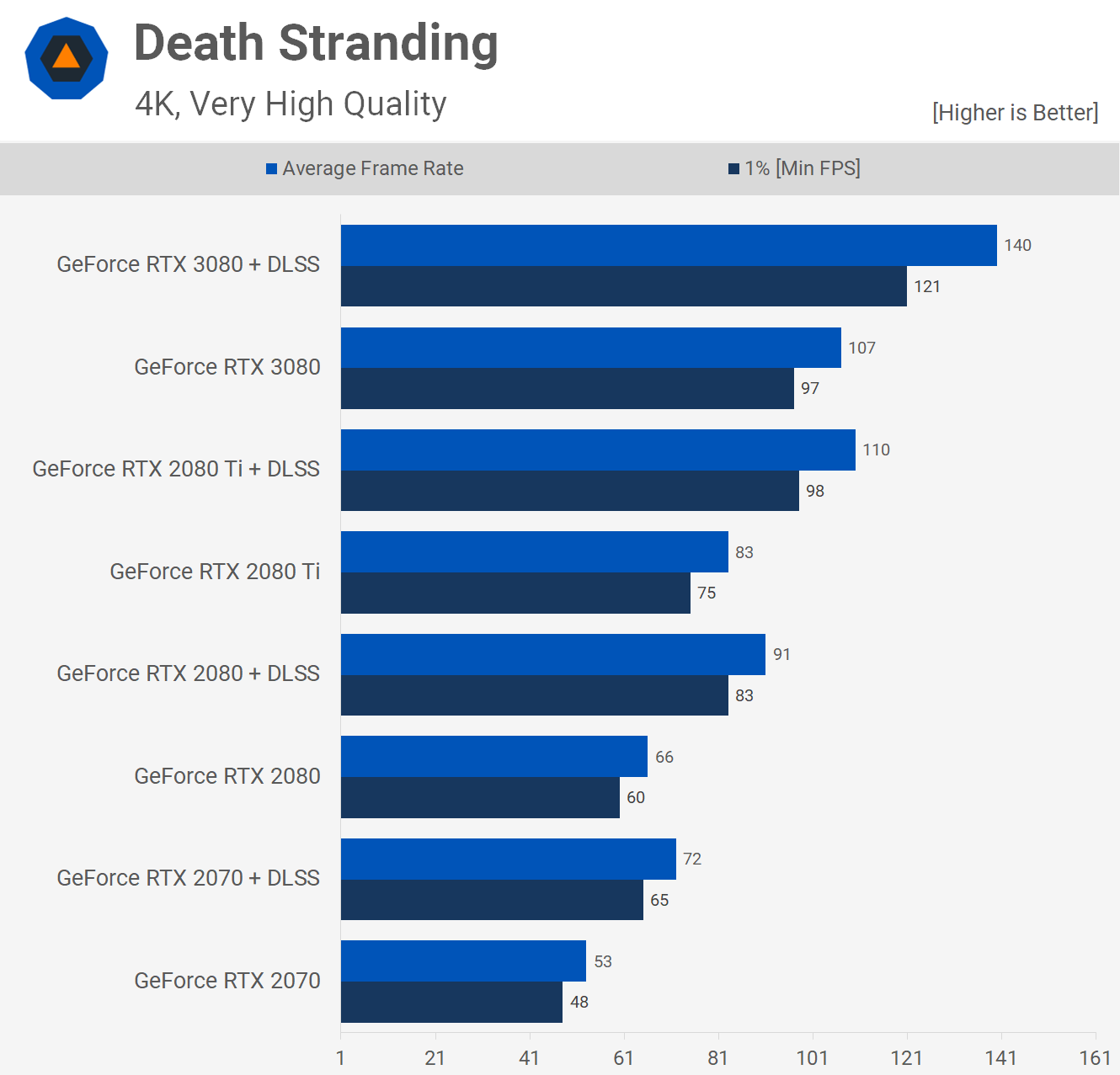
We're going to wrap up with a look at titles that just include DLSS 2.0, so we can see how the RTX 3080 fares when ray tracing is not in the picture.
In Death Stranding, the RTX 3080 receives a healthy performance boost from DLSS 2.0 at 4K, with 31% higher frame rates. Meanwhile, the 2080 Ti sees a 33% boost, and the 2080 gets a 38% boost. We know that DLSS performance gains are better at lower resolutions based on our previous investigations, so this suggests that both Turing and Ampere have similar DLSS acceleration capabilities and we've seen that from previous charts, too.
What this means in practice is that with DLSS enabled, the RTX 3080 is 27% faster than the 2080 Ti in Death Stranding, while without DLSS, the 3080 is 29% faster. You're still getting that class-above performance with the 3080, native 4K performance is similar to what the 2080 Ti can do at 4K with DLSS which is impressive.
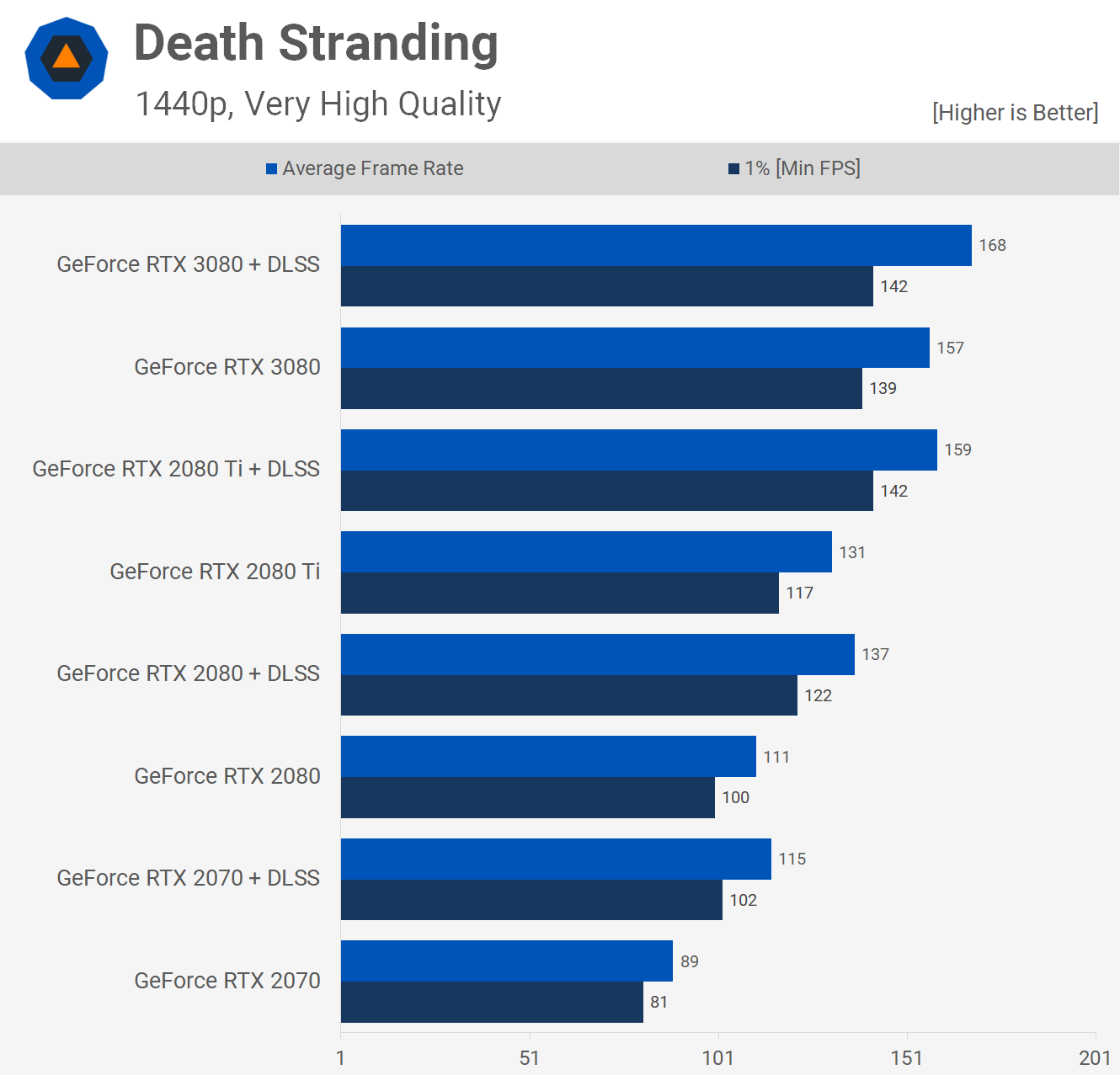
At 1440p we run into more limitations with what DLSS can do, with the 3080 there's just a 7% performance gain, compared to 21% with the 2080 Ti. In the end, the 3080 ends up just 6% ahead of the 2080 Ti. This may be related to a possible bug with Death Stranding and DLSS with lower resolutions, at 1080p performance is actually worse with DLSS enabled, but only with Ampere. It's possible this will be patched or improved.
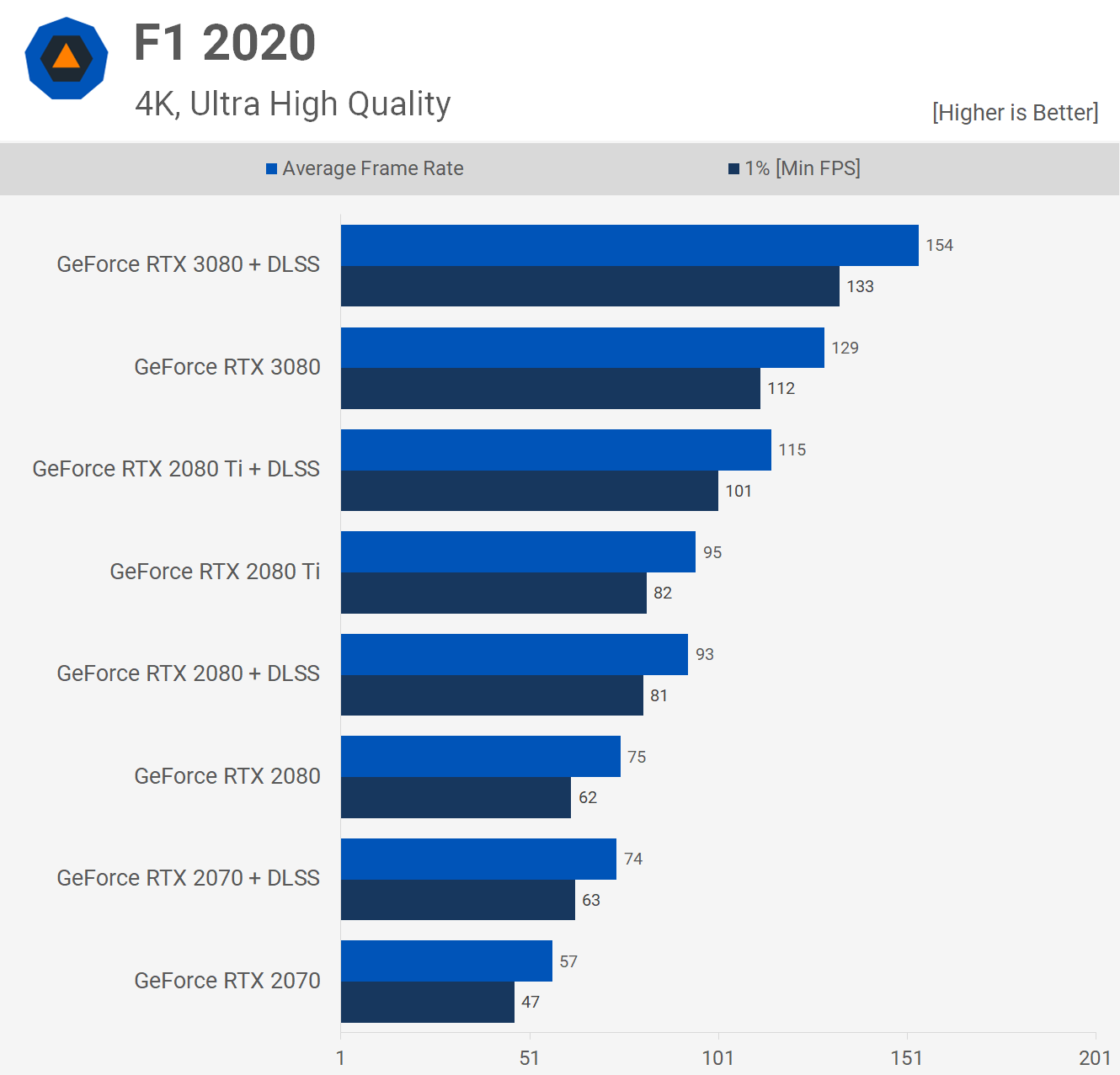
F1 2020 was recently updated to include DLSS 2.0 support. At 4K using the Ultra High quality preset, the 3080 can benefit from DLSS just as it did on Death Stranding, with a 20 percent performance gain. This allows it to be 34 percent faster than the 2080 Ti with DLSS enabled, although the acceleration gains are similar for DLSS between Turing and Ampere.
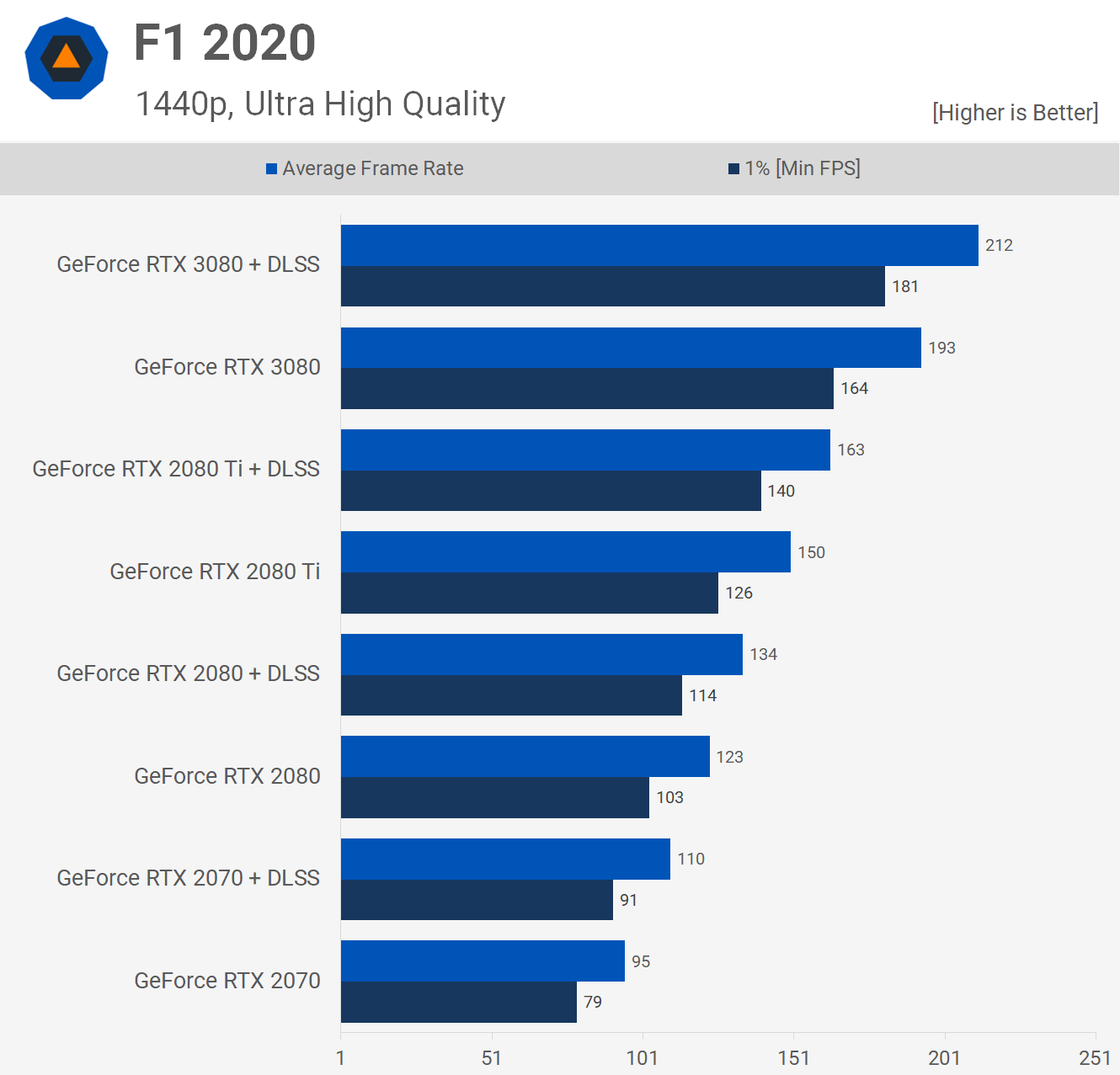
At 1440p, both the RTX 2080 Ti and RTX 3080 deliver a ~9% performance gain when enabling DLSS. We're seeing very high frame rates here, although it's clear DLSS sees diminishing returns the higher the frame rates are. Not that I think anyone will complain about getting 200 FPS at 1440p with this new Ampere GPU.
What We Learned
The GeForce RTX 3080 is the fastest GPU on the market for ray tracing, and the performance on offer brings proper ray tracing capabilities to a new tier of use cases (yes, the RTX 3090 is even faster, but honestly we don't see many gamers buying it over the 3080).
Nvidia has essentially achieved this by brute forcing the design: relative to the RTX 2080, there's more SMs, way more CUDA cores, more memory bandwidth, and more RT cores. This makes the RTX 3080 a much faster card than the RTX 2080 and RTX 2080 Ti overall, and by extension this means the card is also faster in games with ray tracing enabled.
This allows for two major upgrades compared to Nvidia's previous flagship GPU. The big one is 4K gaming with ray tracing enabled. In a lot of titles, the RTX 2080 Ti was barely fast enough for 4K 30 FPS ray tracing, especially in games that didn't support DLSS 2.0. No PC gamer wants to play at 30 FPS – let alone those spending hundreds of dollars in a GPU. This has changed with the RTX 3080, which often approaches 60 FPS and certainly delivers very playable performance in graphically gorgeous games like Control with DLSS and even Metro Exodus without DLSS.
The RTX 3080 is also a much more capable ray tracing option at 1440p. The RTX 2080 Ti was mostly a 60 to 80 FPS card at 1440p with ray tracing in the most graphically intensive games. The RTX 3080 pushes up into the realms of high refresh rate 1440p with ray tracing, and if you're coming from the RTX 2080 which struggled at this resolution, the 3080 will be a night and day upgrade.
We were less impressed by the acceleration provided by the 2nd-gen RT cores and 3rd-gen Tensor cores. There's still a significant performance hit when enabling ray tracing, with a 30 percent drop in frame rate being a fairly typical result. So while you might get say 65 FPS with ray tracing enabled, generally that same game will run at over 100 FPS without it.
With Ampere, there's still that choice between the visual effects of ray tracing, or performance. In some games like Control, ray tracing provides enough of a visual upgrade that you may want to accept the performance hit. In other games, the upgrade is not as significant, so taking a 40-50 FPS hit can be hard to swallow. That's no different from previous generations, it's just that the 3080 is a faster GPU overall.
Our tests also show that ray tracing acceleration in the RTX 3080 isn't overly better than the 2080 Ti's, with less than a 10% speed up to RT acceleration separating the two. In a best-case scenario like Wolfenstein: Youngblood at 4K which received an Ampere-specific patch to improve performance, the RTX 3080 is 25% better at ray tracing acceleration. Ideally, we'd need to see a 50% or even 100% improvement to RT acceleration before the RTX on and off gap feels more acceptable with today's effects.
Because Ampere is only a minor improvement over Turing for acceleration, there's still question marks over whether this card will be sufficient for the next few years of ray tracing. Most of today's games use only one or two effects, and use them sparingly. If games start going all out on ray tracing effects - like what we see with Fortnite - the gap between RTX on and off will grow substantially. More acceleration with more powerful RT cores will be required to keep up. Of course, this is all speculation about the future, so we'll have to see what happens with the next few years of games.
As for DLSS 2.0, it can certainly provide a sizable performance uplift at the same visual quality and in the best of cases, can fully compensate for the losses when enabling ray tracing. We simply wished it was present in more and more titles. DLSS 2.0 doesn't seem to harness 3rd-gen Tensor cores to deliver even more performance than previous cards, at least on current implementations.
With the launch of the RTX 3080, the discussion around ray tracing is very different than it was with the RTX 20 series. Previously, we slayed Nvidia for overpromising and under delivering considering ray tracing and DLSS were two major features they used to sell first-gen RTX GPUs. Nvidia was hoping the poor value of the 2080 versus the 1080 Ti would be overshadowed by how amazing ray tracing is and how it was a must-buy feature. Two years later, there are still few games that support ray tracing, even fewer with ray tracing at release, and Nvidia had to totally overhaul DLSS to make it useful.
With the RTX 3080, we're in a totally different position. The card offers much better value than the previous generation, thanks to serious gains to general game performance and lower prices. This makes ray tracing more of a bonus feature - the way it should have been before. It's much easier to overlook the small selection of games with ray tracing when in all the other games you are getting 20 to 30% more performance than a 2080 Ti for $500 less.
From here, we think it's going to be smooth sailing for ray tracing. The hardware is more capable, we'll see more games with better ray tracing effects, new generation consoles will support it, and we'll also see competition from AMD, and eventually Intel GPUs on the PC.
